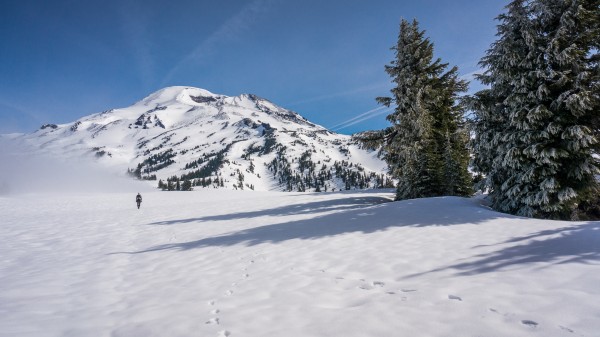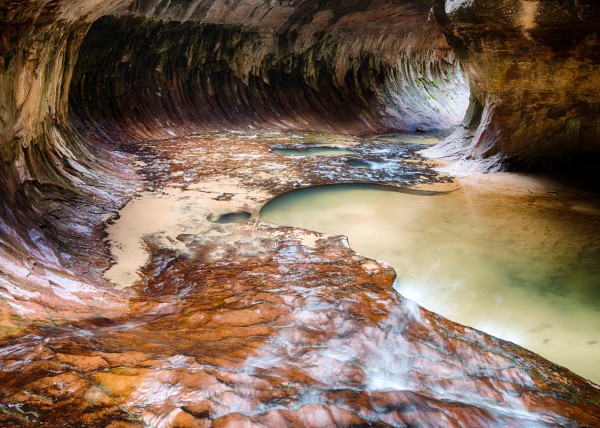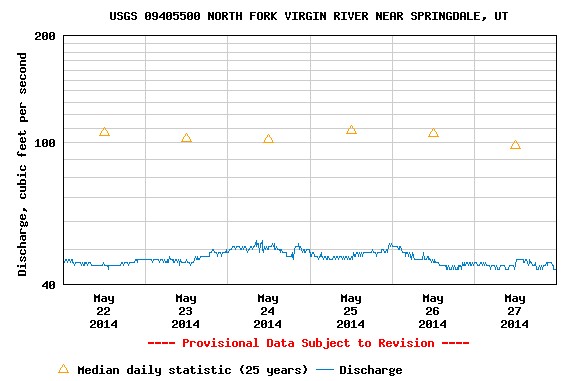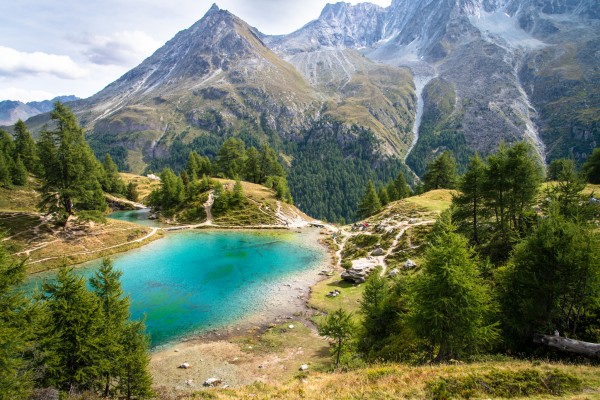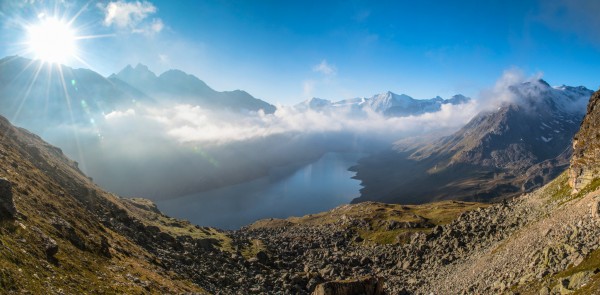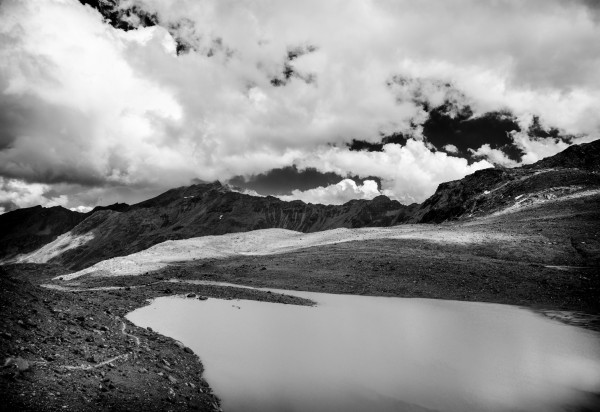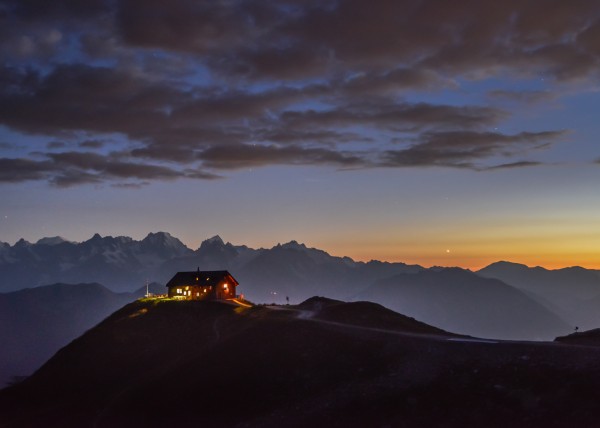14
2014Anne and I have talked about climbing the South Sister in Oregon for a little while now. We decided this past week-end to use the excuse of our six-year anniversary to take an extra day off, drive down to Bend, and notch the peak off our tick list.
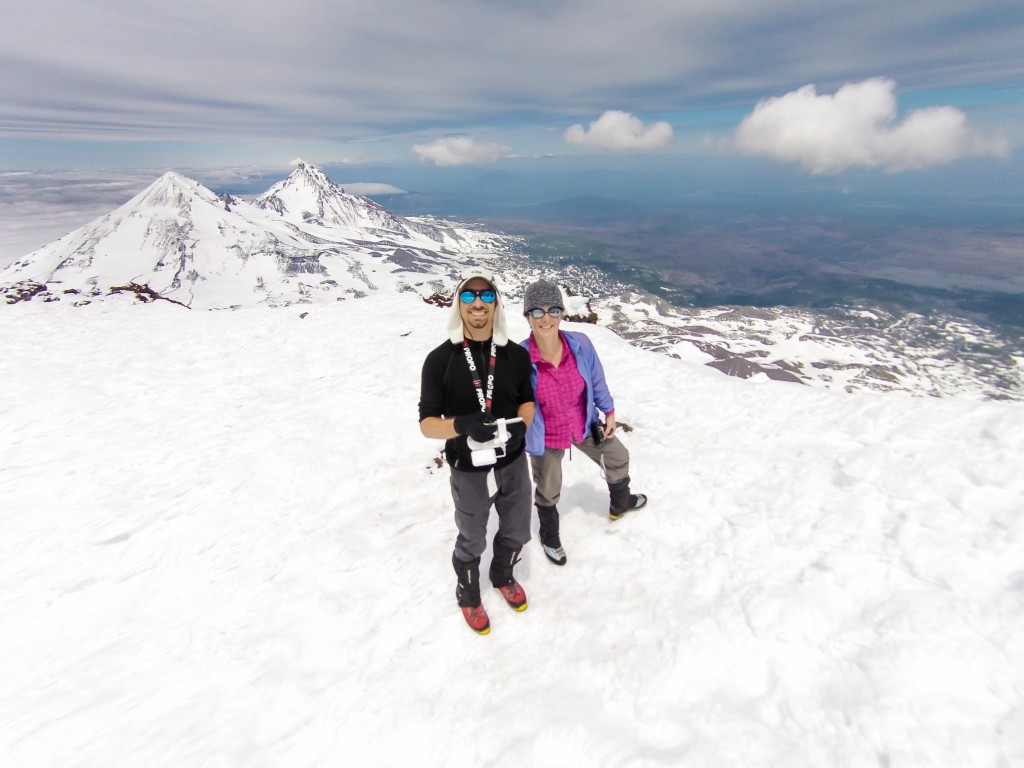
As overnight temperatures were cold, we allowed ourselves a 6am wake-up call that allowed for warm lattes in Bend and a little time for the snow to soften. We packed crampons, ice axes, hiking poles, and the Phantom 2 Vision for some aerial videos and panoramas. After less than a mile, the trail turned to snow and essentially remained snow-bound until the summit. The low overnight temperatures ensured the snow was very firm and in most places easy to walk on without breaking the surface. A low cloud layer (possible inversion) kept temperatures cool.
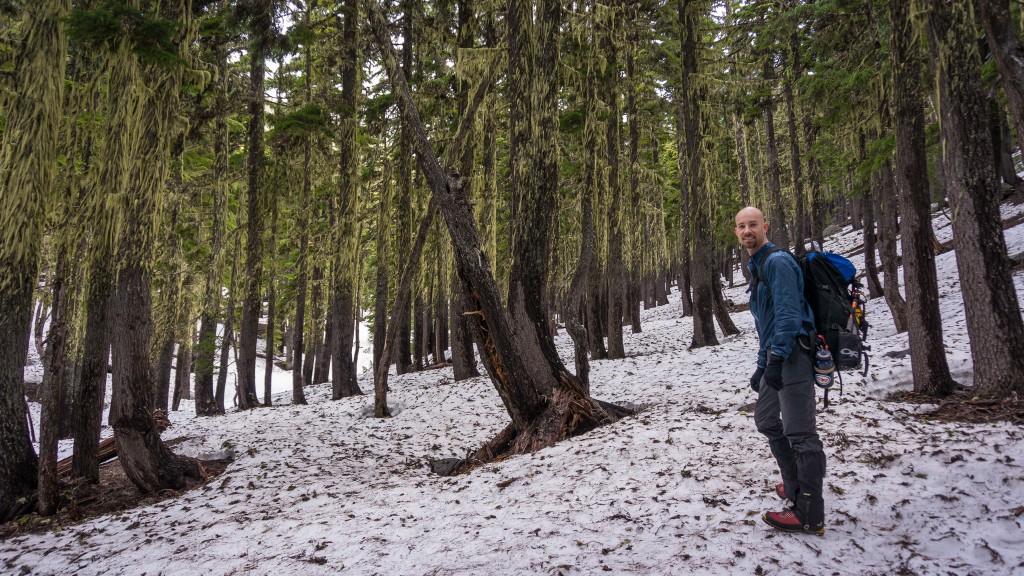
In an enchanted forest (photo by Anne Archambault)
We ascended to the flat section above Moraine Lake where the clouds wrapped around us and limited our visibility. I pulled out my GPS to ensure we stayed on course until we finally peaked above the clouds to a bluebird morning with stunning views of Broken Top and South Sister.
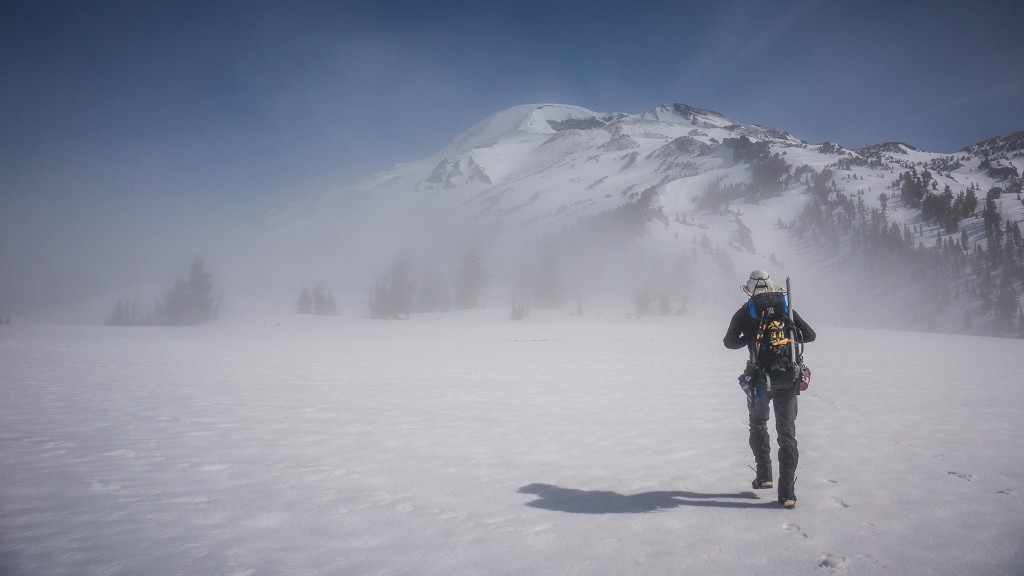
Coming out of the whiteout (photo by Anne Archambault)
The climb itself was relatively straightforward. We made our way up very firm snow and put on our crampons for a short while until the sun warmed the surface enough to ensure good purchase.
We made good time up to the first basin before slowing on the long rock ridge up to the actual summit crater. Here it was clear that some interesting weather had blasted the mountain since the previous weekend. There was significantly more snow on the rib than we saw in photos from a previous trip report and some significant deposits of rime ice.
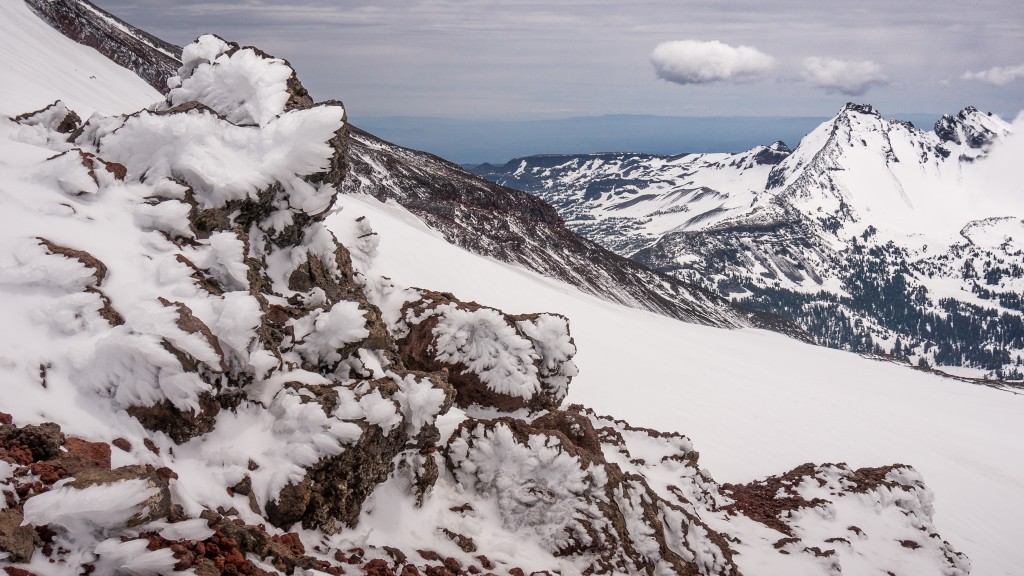
Crazy Rime Ice (photo by Anne Archambault)
The final ascent from the rock rib to the summit involved a steep hill over some pretty firm snow. It wasn’t technically demanding, but the run out was risky at best and offered a somewhat daunting psychological challenge if you looked down and spent time thinking about the consequences of falling. I did my best to kick good steps and move quickly.

Long climb up the rock rib (photo by Anne Archambault)
Cresting the crater rim was exhilarating, the sun was out and the temperatures were surprisingly warm. We quickly completed the final traverse to the true summit and spent the next hour relaxing, eating, and flying the Phantom with spectacular views all around.
The time spent on the summit allowed the snow to further soften for the descent, which made for quality plunge stepping and enabled us to make good time. The soft snow did slow us down by the time we reached the long and tedious flat section. Traversing the flat felt tiring at the end of a long day, but once complete the path wound quickly back to the comforts of our car, sandals, and the inevitable burger and beer in town.
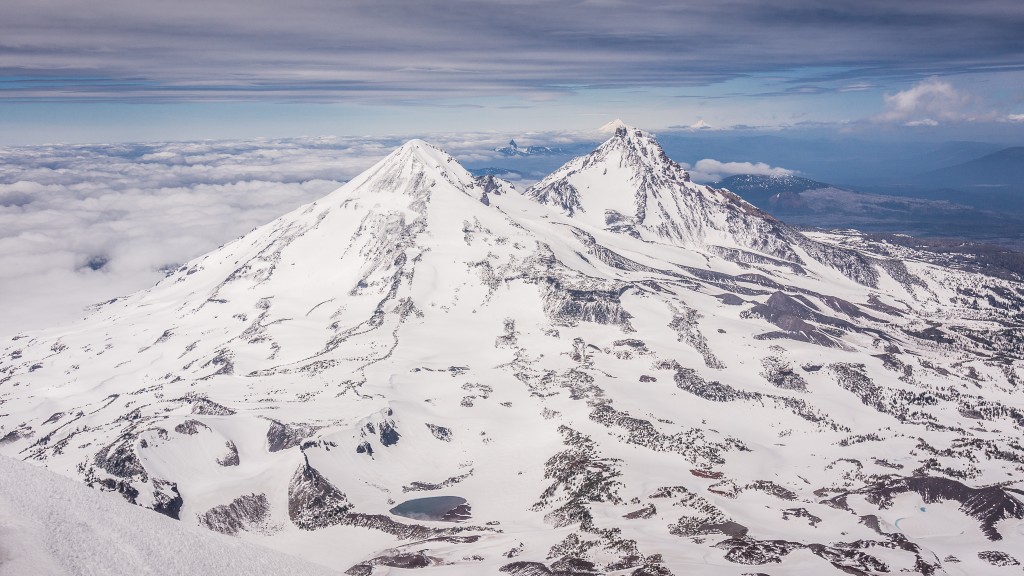
North and Middle Sister (photo by Anne Archambault)
Overall, an awesome summit with spectacular views.
And for those interested, here’s the GPX track:
Max elevation: 10394 ft
Min elevation: 5410 ft
22
2014Anne had a conference in Las Vegas last week so we took the opportunity over the long weekend to visit Zion National Park and hike some canyons. Anne’s always super on top of stuff like this, and like the pro she is was able to get us permits for both the Virgin Narrows overnight as well as the Subway over the Memorial Day weekend. Pretty amazing!
Virgin Narrows
We organized transportation with the Zion Adventure Company to drop us off at Chamberlin Ranch. There’s at least one other company that does hiking shuttles to the ranch, but ZAC allowed us to cancel our reservation if weather turned bad, which we preferred given the advanced scheduling we were doing. ZAC also provides rentals on gear like Five Ten Canyoneer shoes and things like dry pants. While Anne didn’t wind up renting a pair of shoes, we both opted for a pair of dry pants. This was for several different reasons:
- Guidance from ZAC that about 50% of hikers in the Narrows were renting pants
- Water depths were between mid-calf and mid-thigh for most people
- Water temps were around 56 degrees Fahrenheit
- Overnight/morning temperatures were relatively chilly (mid 50s or so)
- The steep walls of the canyon would likely keep the canyon in the shade
We kept a close eye on the water gauge readings, which confirmed relatively low flow and water levels. For those going on the hike, I can confirm that at the rates below the deepest the water ever got was to my waist in one particular hole. Consistent water depth was generally no deeper than my knee (I’m 5’11).
In terms of our kit, we travelled as light as we could on camping essentials to ensure we could carry our camera equipment. In favor of a hot meal, we packed two sandwiches and relied on cold breakfast of beef jerky, nuts, cheese sticks, and Clif bars. Hot tea would have been nice for the chilly morning, but wasn’t strictly necessary. For camera gear, Anne and I both carried DSLR cameras with wide angle lenses (I rented a Nikon 16-35 f4) along with tripods, long exposure filters (6 and 10 stop), and an extra battery. I also carried along a GoPro on an 18” pole for video and such. With tripods, food, water, Steripen, first aid, GPS, sleeping bag, sleeping pad, and clothing my total pack weight was somewhere around 30 pounds.
Because of our particular logistics, we weren’t able to pick our permits up the day before our hike, so we needed to book the 9h30am shuttle, which put us at the ranch around 11am. ZAC’s shuttle runs from the store just outside the park, stops at the East Rim Trail, Orderville, and finally Chamberlin Ranch. Backcountry hikers should be aware that the park asks you to put a small sticker inside your car so they can identify your vehicle should some particular emergency arise. Should you have valuables, it’s a pretty good way to spot who might be gone for a while. That said, people we talked with didn’t seem to indicate petty crime or vandalism was a problem. The shuttle was a 12 person van, which was pretty full and required backpacks to go on the roof rack.
The trail starts simply as a road meandering through the lush upper pasture of the ranch, crossing the Virgin River (at this point really just a small stream) almost immediately and then paralleling the river for a couple miles. After Bullochs Cabin, the road narrows to a path that pretty immediately joins the river for the rest of the hike.
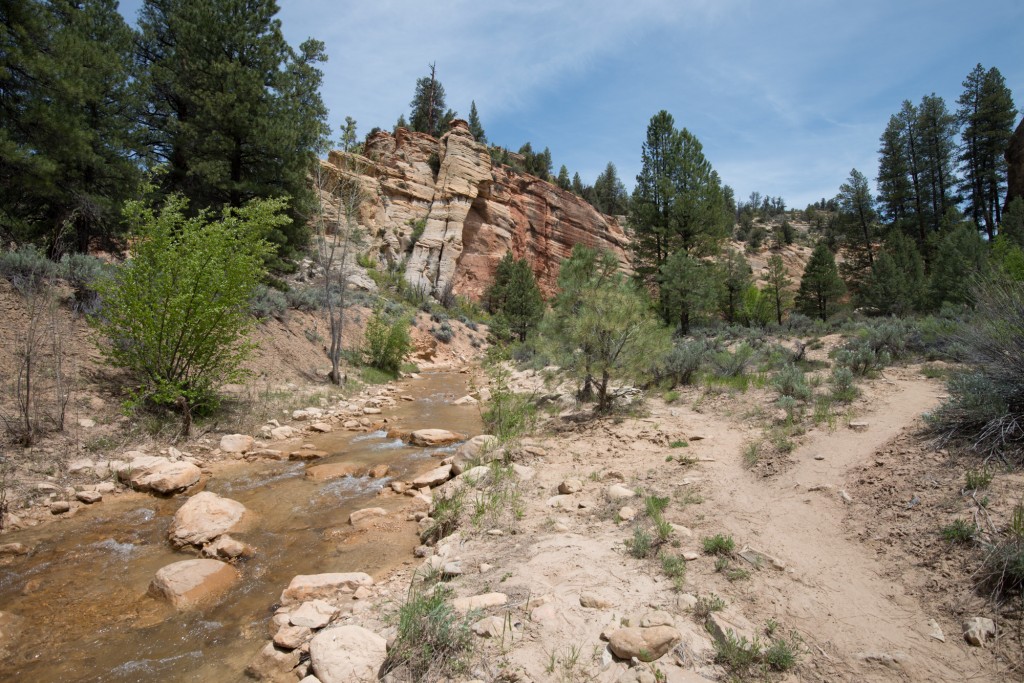
Foot paths repeatedly cross the river for the first couple miles as the valley generally narrows around the river and the walls grow larger. This part of the hike is still quite exposed to the sun and I was unhappy that I’d left my sunglasses behind mistakenly thinking that we’d be sheltered for the duration of the hike by towering canyon walls. The day was warm and so we enjoyed our frequent crossings in the water to help cool off. Water levels here were quite shallow, generally no deeper than ankle or lower calf.
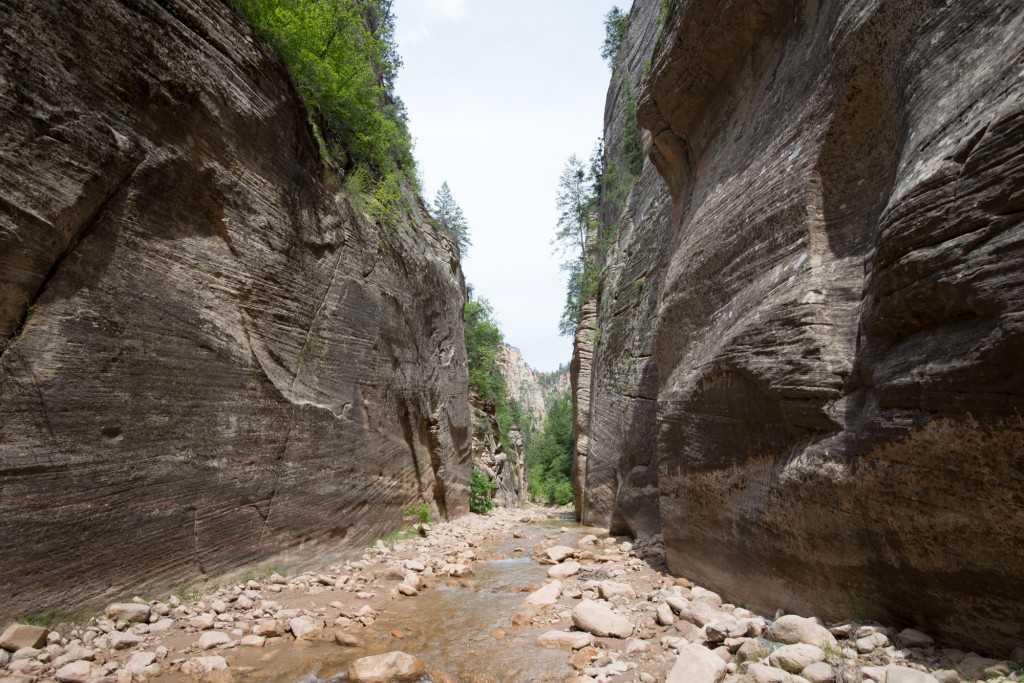
Gradually, the walls continue to narrow until you reach the upper narrows, which close around you like a proper narrows should. These are certainly fun to walk through, a little dark, and keep you in anticipation of the next corner. In short order after the narrow part of the narrows you’ll reach the falls, which can be circumnavigated on the south side (look for a small cairn on the left side of the canyon). This then leads quickly to the Deep Creek confluence, your first opportunity to filter water, and campsite #1 immediately on the left side.
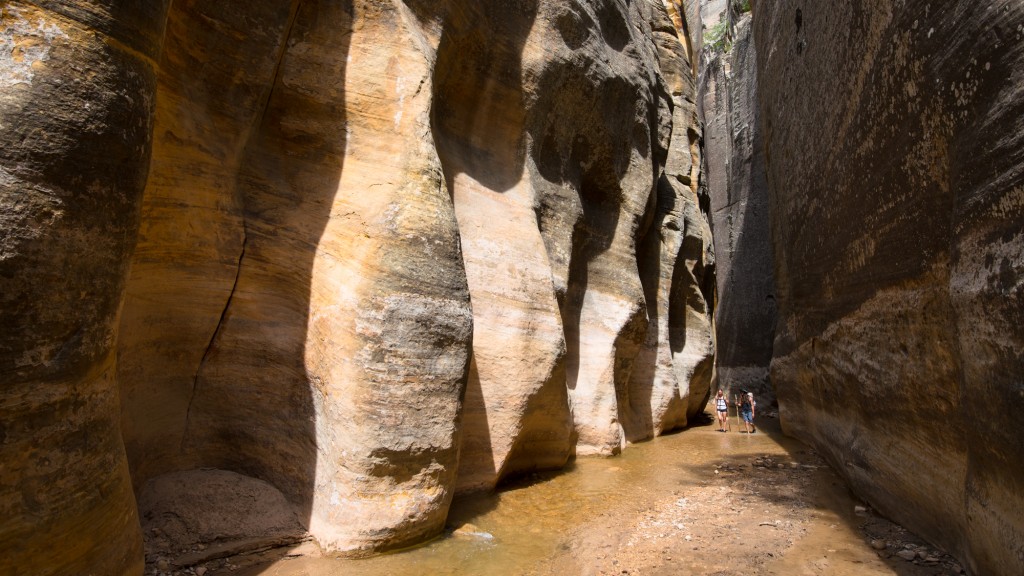
Note: The Park Service recommends only drinking water after the Deep Creek confluence because of the agricultural runoff in the upper Virgin River.
Our campsite was #5, which was almost at the confluence of Kolob Creek. Unlike as shown on the park map, site #5 is not shared with site #4, rather it’s probably a couple hundred yards downstream. Also to note, while the Kolob confluence is hidden from sight when at camp #5, it’s actually just 20 yards down river and should certainly be explored if you have the time/energy. We didn’t know and feel like we missed out. Also to note, sites 2 and 3 had some pretty awesome places to sit and chill, with makeshift benches.
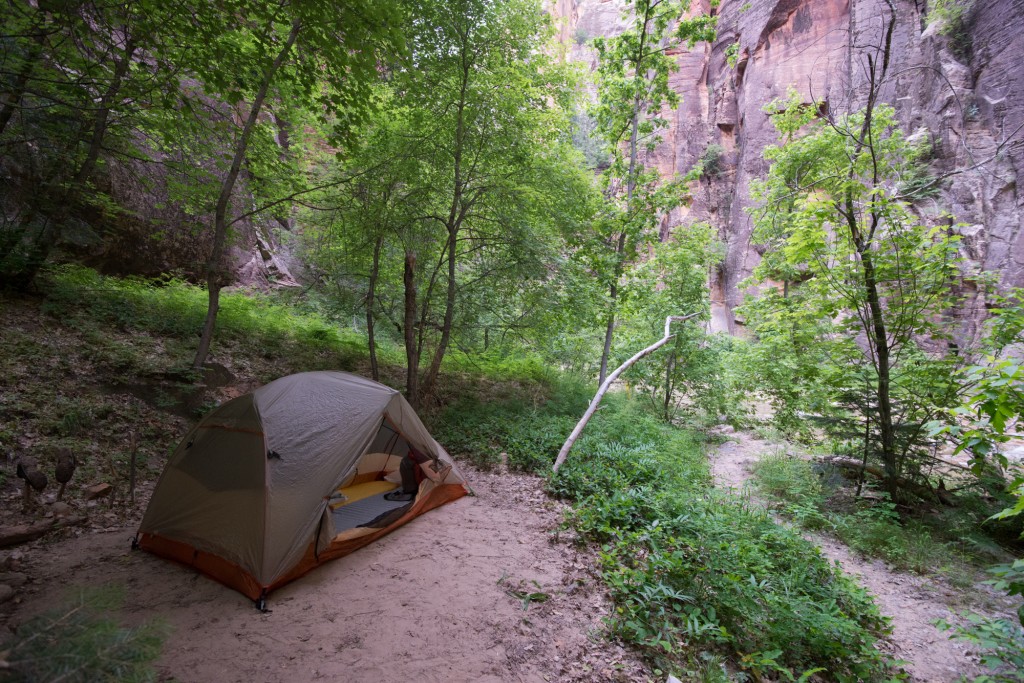
We awoke the next morning to overcast skies. The weather forecast hadn’t been superb and we knew there was a chance of afternoon showers so we moved at a pace that generally precluded taking lots of pictures. This decision was backed up in practice when it started raining on us. However, we soon started meeting day hikers coming up the Narrows from the bottom and that gave us some reinforcement that we weren’t in grave danger of being swept away by flash floods.
The primary narrows on the lower section of the trip was just above the Orderville confluence. The joining canyon is rather small and could almost be missed by hikers coming from the top. For hikers coming from the bottom, this spot marks the beginning of the short section of truly narrow narrows up to Deep Creek.
The trail at this point is pretty much in the river. Where possible, you can hike along the edges of the river course along small embankments or sometimes on well-defined paths in the flood plain. The park service advises against, and has signs to deter, hiking in higher spots along the canyon to prevent erosion. Because the path is more or less over irregular terrain, progress is generally slower than what you’d expect on a maintained trail.

The sun did break near the end of the trip, so we broke out camera, tripods, and the rest of the equipment to capture some of the more iconic spaces in the lower narrows.
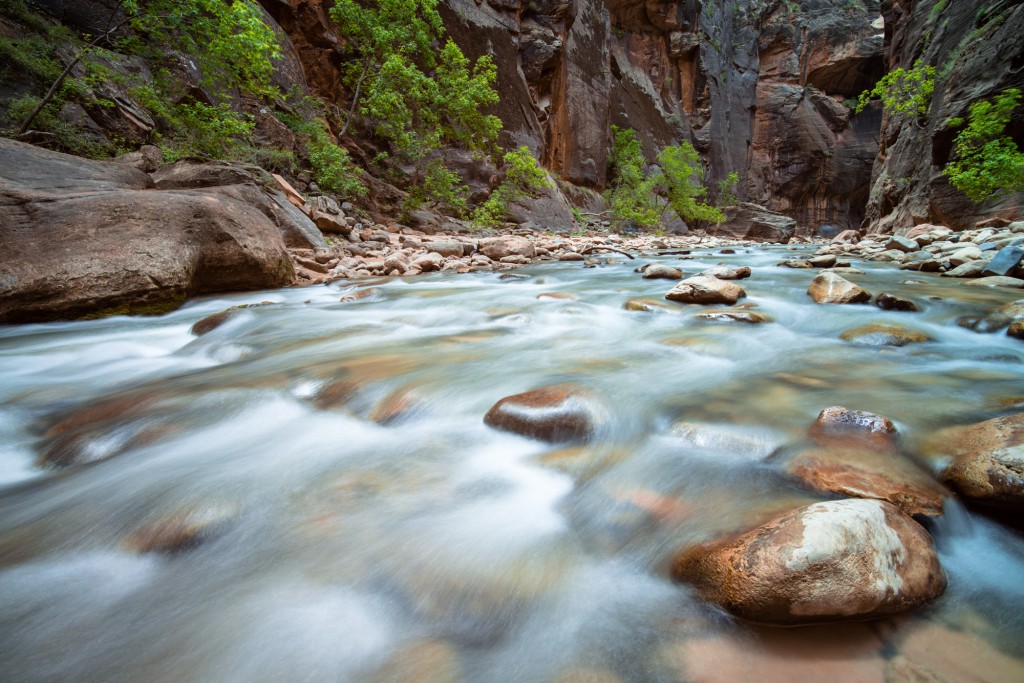
After a few more twists in the canyon, we found that our trip was at an end and we were at the paved trail leading to the Temple of Sinawava. Overall, a pretty grand trip. Anne and I hadn’t been on an overnight trip since this past winter and it was great to get away from crowds and do what many consider to be an iconic hike. While I was hoping for more accommodating weather on the second day, I certainly couldn’t argue with either the water level or generally the temperatures given our use of dry pants. On retrospect, the dry pants were critical for comfort on the trip and were a wise investment (despite the fact that we didn’t use them at all the first day).
Kanarra Canyon
Our next canyon was the Kanarra Canyon in Kanarraville about an hour outside of Zion. The hike is relatively short, has an easy approach, and provides nice narrow and scenic slot canyons with at least two very nice waterfalls and some sporty if not difficult ladder climbing.
Parking for the canyon is in a parking lot at the base of the access road and costs $10 for the day. You can park for free at the city hall, and you should be aware that it’s not permitted in Kanarraville to park on the street (or at least not for visitors).
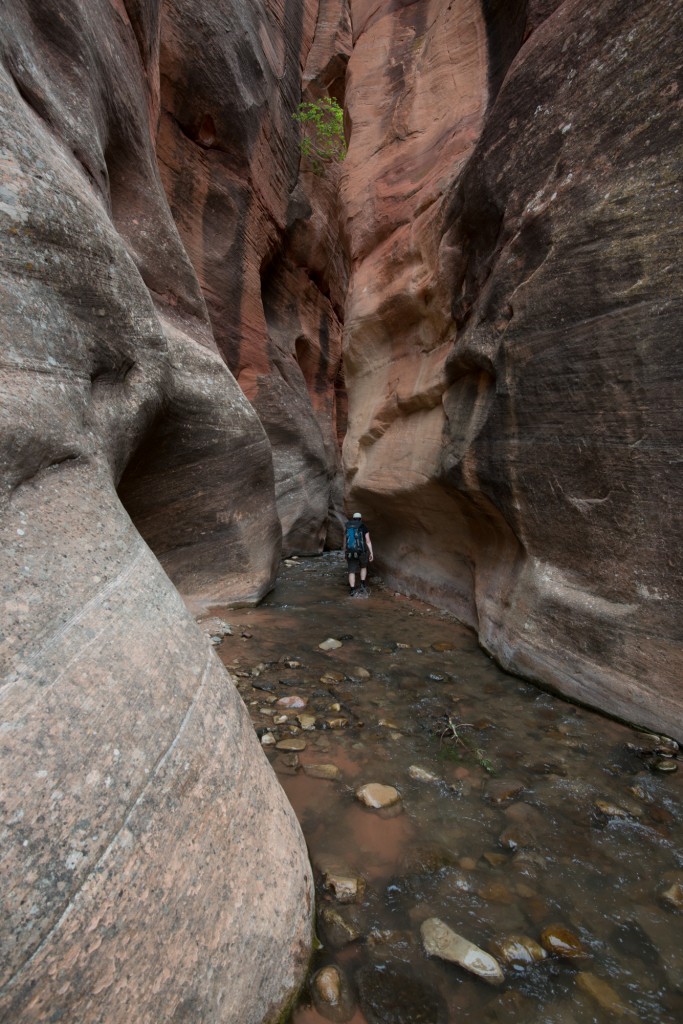
The path follows an access road for a while, gaining, then losing, then slowly gaining elevation again. After about 1 mile (possibly less) the trail joins Kanarra creek, initially crossing it for a short while and finally joining with it. The first slot comes up rather suddenly and is narrow, somewhat tall, and completely fun. This ends quickly in the first waterfall that is well provisioned with a “ladder” that allows hikers to climb up to the top.
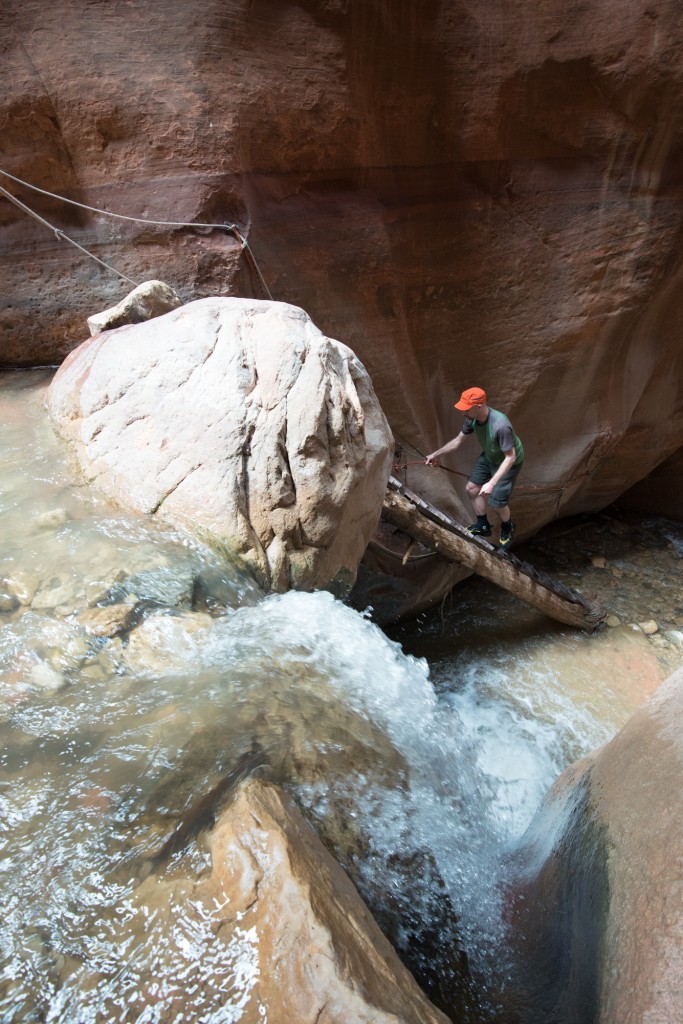
The next section works past some slide debris, through a wider area of the canyon before coming to some slick rock falls (and a nice natural water slide), a side canyon confluence, and the second of the narrow sections of the canyon that leads to the second waterfall. Here the ladder consists of a two rung wooden ladder strung up on the rock with a set of ropes. The whole contraption is somewhat unstable but has foot loops, hand loops, and knots to make the ascent completely possibly if somewhat ungainly. This is where we stopped and turned around.
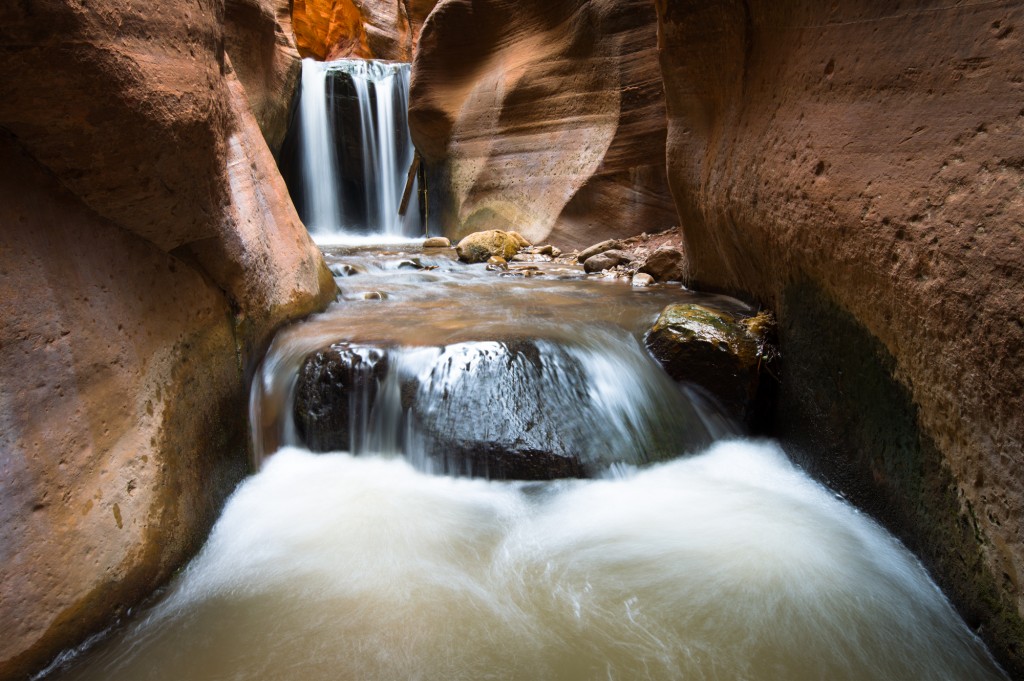
In terms of bang for the buck, it felt like it was pretty hard to beat Kanarra Canyon. Access was short without a lot of elevation gain, there are a couple very nice narrow sections to the canyon, and there are a number of water features that could keep photographers occupied for hours. For families, there are a couple nice pools to cool off in, a great area for lunch, and a natural water slide. Overall, I thought it was an excellent canyon.

The Subway
Our final canyon of the trip was the venerable Subway. We chose to do the canyon as a round trip from the bottom given our photo gear though most of the traffic we saw during the day (at least 40 people) came from the top as a true wet canyon trip.
We read one description of the bottom up round trip route as not being worth the effort. It proclaimed the hike as disappointing if you only come to look at the Subway and implored readers to do other hikes in the park. After hiking the trail, it’s somewhat hard to disagree. The hike in is laborious and in the sun it’s also hot. Because most of the trail follows the river, it’s constantly criss-crossing the water and rock hopping. That said, Anne and I both had times where we were able to lose ourselves in the beauty of the place.
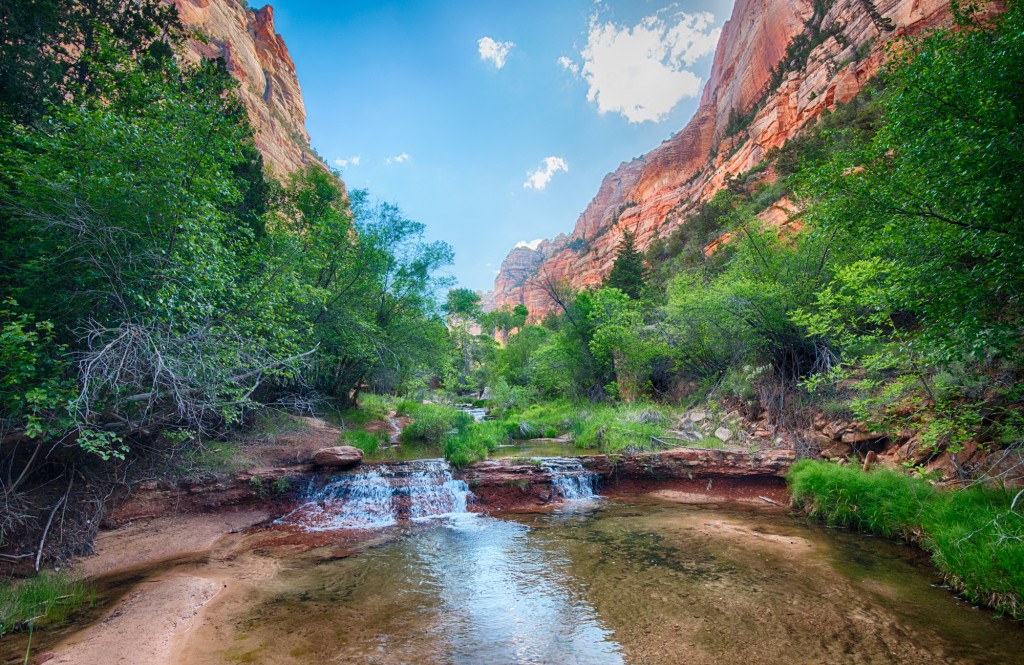
The bulk of the trail can be done dry, and until the last half mile or so we hiked in our normal hiking shoes. Once we reached the slick rock formations, we transitioned into our wet shoes (for Anne these were sandals, for me it was a pair of Five Ten Canyoneers). Once wet, I did the rest of the trip in my wet shoes. On hindsight, I should have only carried a single pair of shoes (the Canyoneers) and saved myself the trouble of keeping my feet dry on the way in, which would have made route finding easier.
Of course the highlight of the trip is the Subway formation itself. This comes at the very end of the outbound trip and is really just the last 100 or so yards. Given the name and the pictures I’d seen, I had expected the rock to overhang the formation more. However, careful placement of the camera can provide the illusion that the Subway is somewhat more covered and subterranean than it actually is.
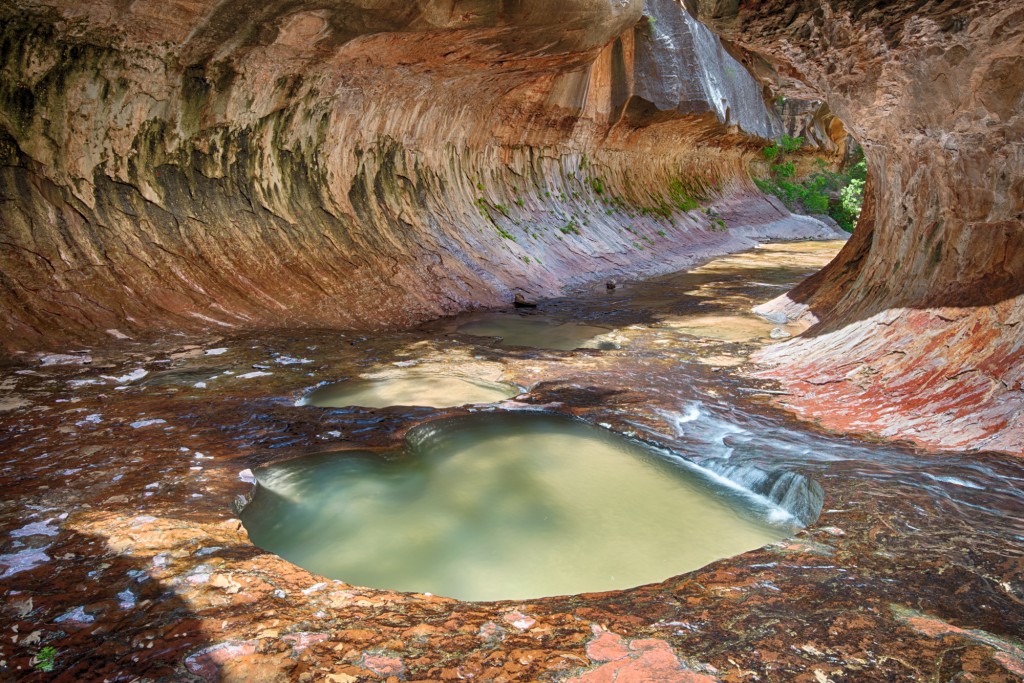
Time of day is also important. Because the trail in took us longer than expected, we arrived shortly before noon when harsh sunlight was streaming directly down into the slot. It turns out that the best light for the Subway is either mid-morning or mid-afternoon, which helps soften contrast inside the formation while helping to light the “entrance” and “exit” of the formation. Unfortunately, we needed to leave before the afternoon sun the right location.
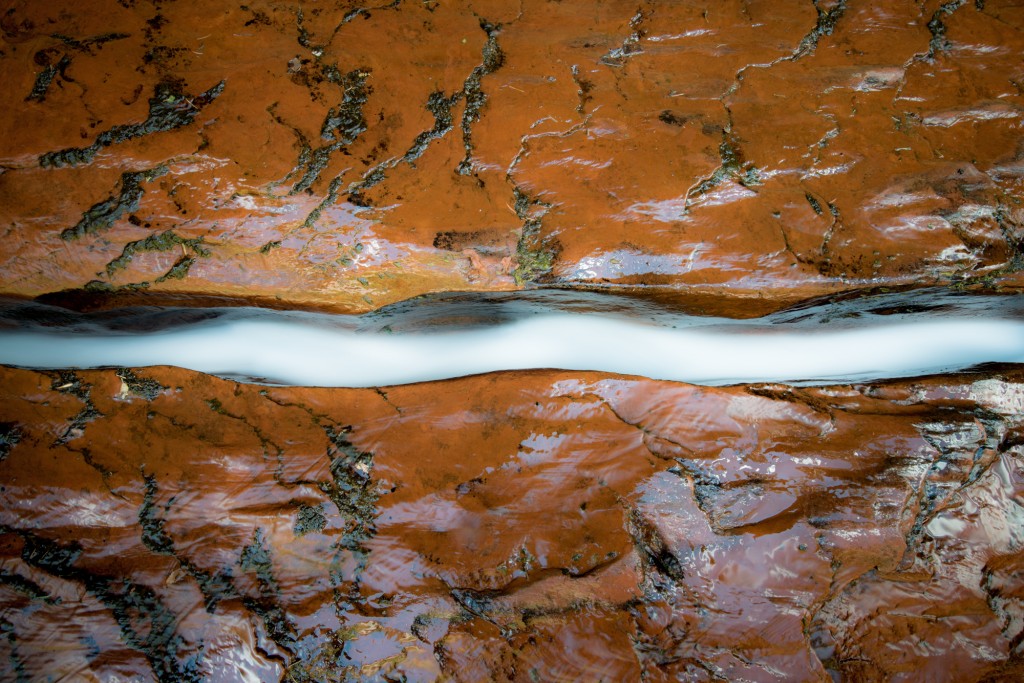
The second highlight of the trip was the slick rock formations and waterfalls. There is a small channel in the rock, literally around the corner from the Subway (possibly 200 yards downstream) that’s also a popular photography subject and one that Anne and I spent a lot of time photographing. This location is best in the morning while the rock is still in the shade. When we left around 3, the light was directly on this area and quite harsh.
Summary
While I’ve visited Zion National Park previously, I never felt like I’d truly explored the park in a way that wasn’t just superficial. This trip allowed us to see some of the classic sights of the park, get some great photos, and simply enjoy a wonderful long weekend in a spectacular area of the country.
07
2014Day eleven marked the last true day of “tough” hiking with a route that lead over the Augstbordpass and into the Mattertal valley to St. Niklaus. We woke early, grabbed a filling breakfast, and headed out into the cool and overcast morning. For the previous couple days, the weather had been starting to turn more seasonal, both cooling and becoming more overcast.
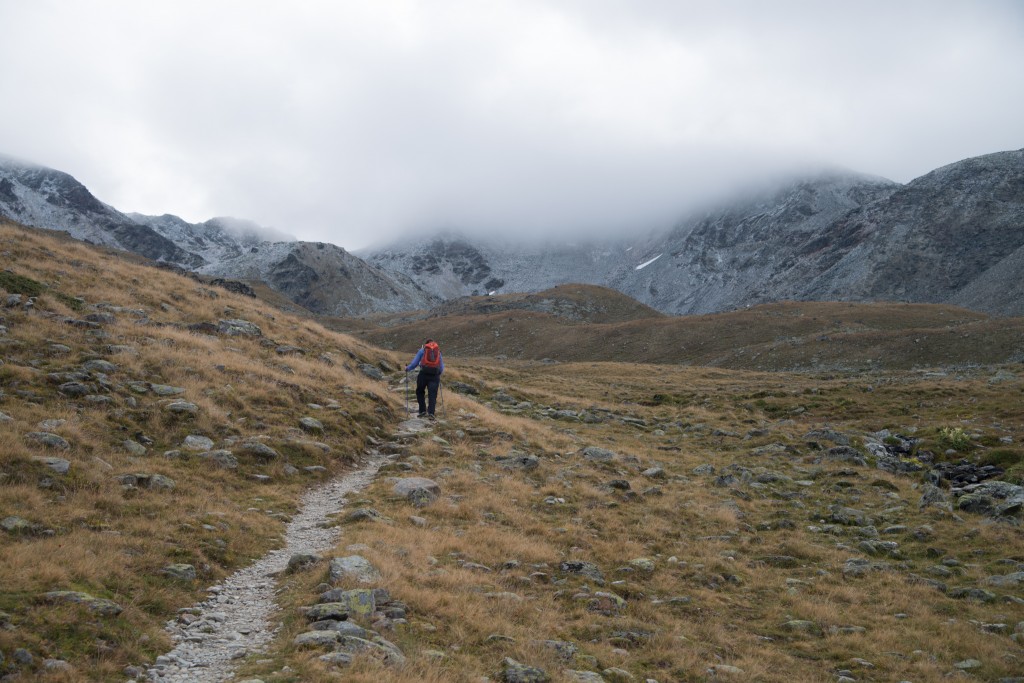
The hike itself goes virtually straight up towards the col, heading steeply up the side of the valley before following a smaller valley up to the Augstbordpass. As we climbed, the views back over the valley opened up and we heard the characteristic clang of cow bells as herders brought back in their cattle for the season.
At one point, a young man passed with a small herd of cattle following. Anne and I stepped off the path to allow the caravan to pass and were viewed inquisitively by the passing bovine.
As we headed up the valley, the wind picked up and the temperature seemed to drop.
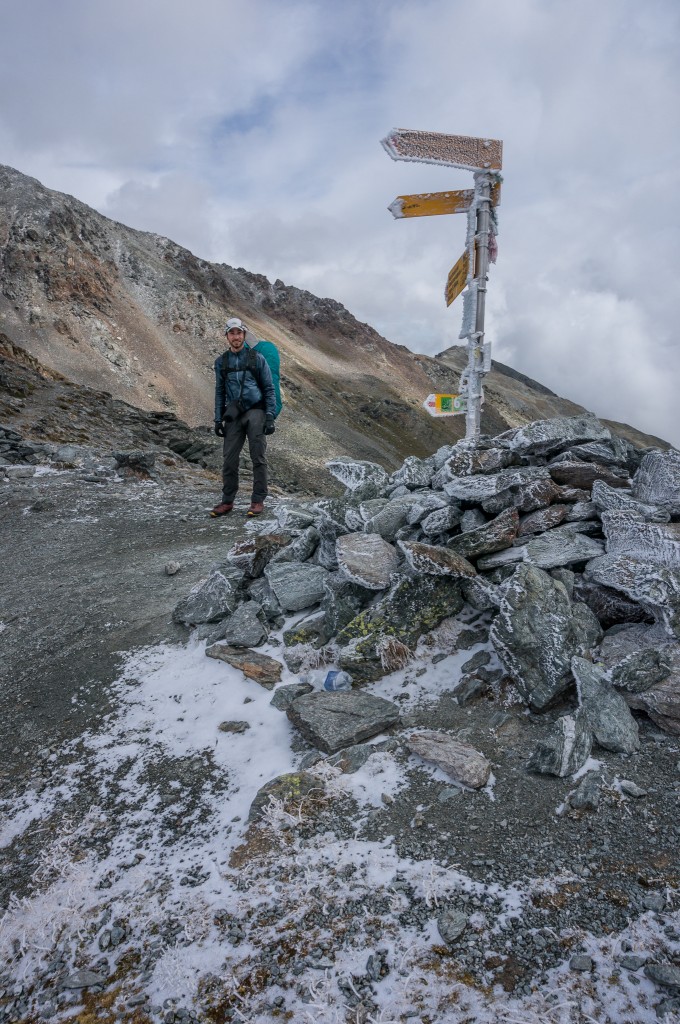
The final climb to the pass was bitterly cold with rhyme ice covering the plants, rocks, and sign posts. We stopped quickly for the obligatory pass photo before dropping down into the Mattertal in search of a respite from the biting wind and cold.
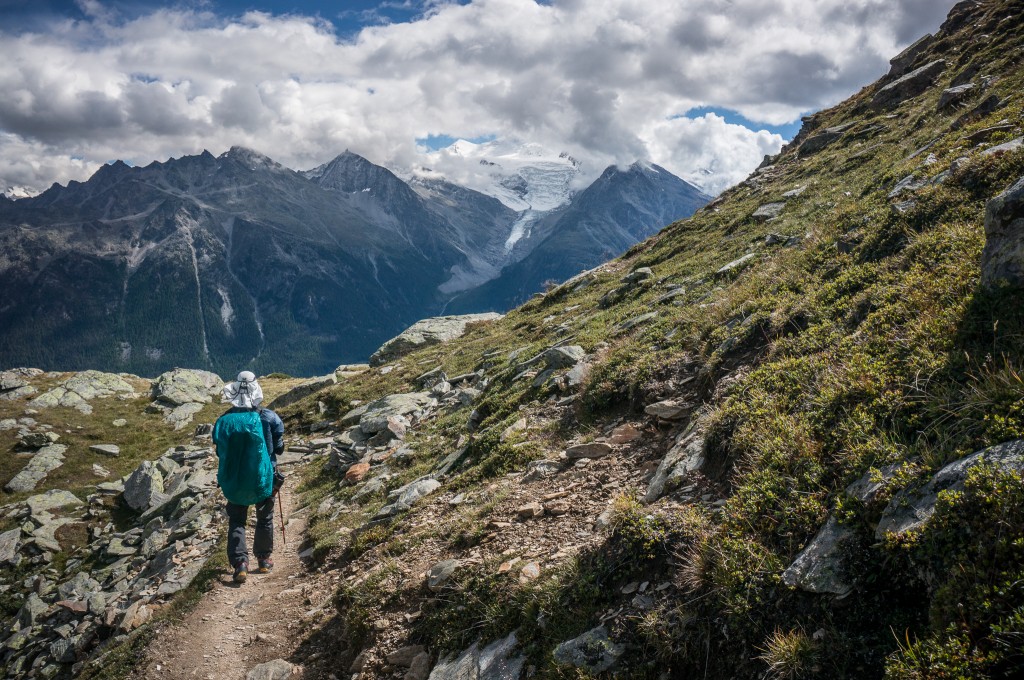
This path descends directly down a small side valley before cutting sharply right and traversing along the valley side along a mostly scree slope that is sometimes exposed. The slight amount of gain is rewarded handsomely at the Twära overlook.
The path from the overlook led relatively directly and steeply to the small town of Jungen. While it was possible to see Jungen a short while after passing the Twära overlook, it took considerably longer than expected to actually reach to the town. Here we ran into Rich, Denise, and Brian eating at the Junger Stübli where we sat down to rest and enjoy with them for a short while. Take note, there is a room for let in the Stübli and if you have the time you should certainly try for it since it would afford excellent views in one of the most beautiful small Swiss Alp villages I’ve ever seen.
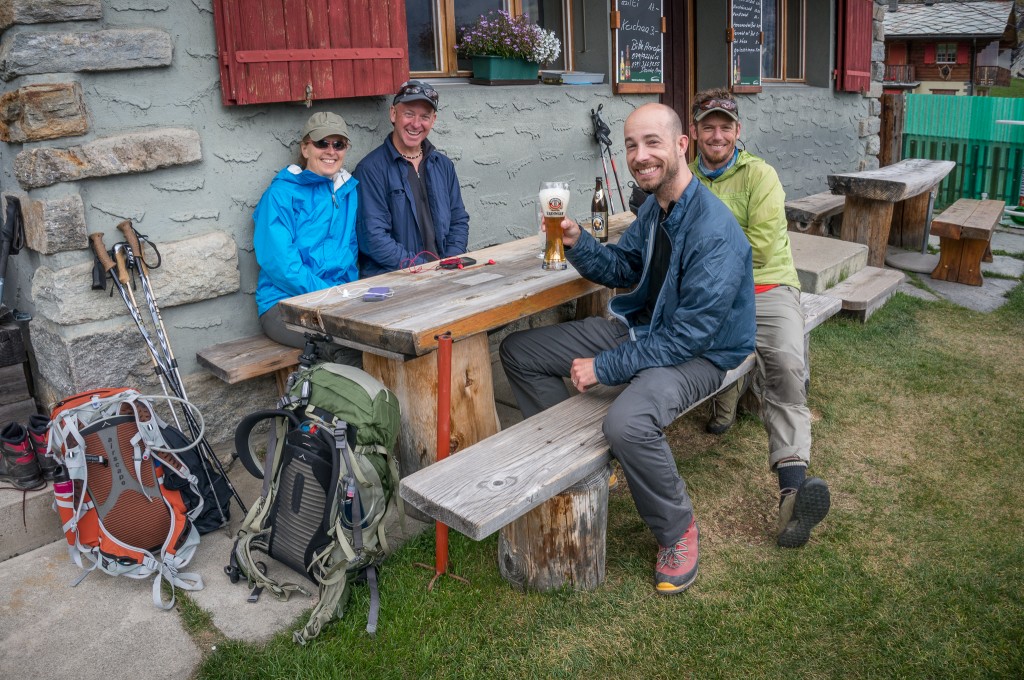
The rest of the path to St. Niklaus was relatively straight forward and took about an hour to complete with our sore legs and tired backs. Arriving in St. Niklaus, it’s a little easy to get overwhelmed with the size and complexity of the town having just spent over a week in very small villages. We had to ask directions to make it to our hotel at the south end of town but we arrived soon enough and settled into our room, happy to be one day away from our final objective of Zermatt.
Max elevation: 9485 ft
Min elevation: 3665 ft
09
2014As mentioned previously, from Zinal there are a couple options for hikers on the way to Gruben. Our path led us over the Forcletta directly to Gruben. However, it’s also possible to take a detour towards the Hotel Weisshorn and then pass towards Gruben via the Meidpass. This second option allows trekkers to inject a stay at the Hotel Weisshorn, which is recommended in the guidebook if you have the time to spare. This can also be accomplished as day hike to Gruben by adding on distance and a little more elevation gain.
Because Anne and I were on a tighter schedule than we’d first thought, we needed to head directly to Gruben in order to have a full day to enjoy Zermatt. This led us up towards the Forcletta. The path out of town was a little hard to find and the directions in the guidebook didn’t map well to the surroundings. We headed up past the church and then broke left on a road that led to some construction and finally between the large apartment blocks indicated in the book description. This then led uphill out of town, steadily gaining elevation and traversing along the valley side with intermittent views.
The trail here is well graded, almost flat in fact, and is some of the best trail along the entire route. Here the trail winds into one small side valley at Barneuza before coming back and continuing its traverse down the valley. Before long, a second deeper side valley causes the trail to turn right. At the head of this valley the trail splits, a steep trail cutting right leads to the Forcletta while the well graded path continues along a climbing traverse towards Hotel Weisshorn.
Anne and I headed right and started the steep ascent towards the col. This trail was obviously new, created by some crazed Swiss farmer who drives heavy machinery directly uphill rather than forming more logical and well graded switchback. Here the trail climbs steeply towards a small house and barn where it again levels out, crosses a pasture, and then again climbs steeply towards the col.
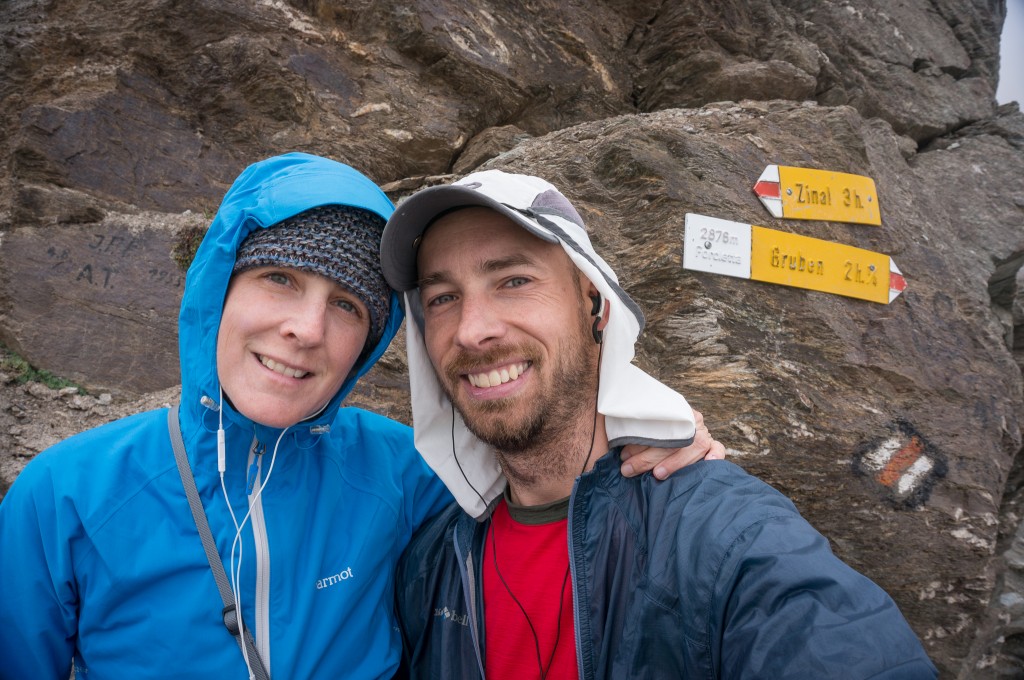
By this time, the pleasant morning weather had given way to clouds, wind, and generally cold temperatures that caused Anne and me to bundle up more than we had in all previous days of hiking. It also meant that the stupendous views discussed in the book were obscured in clouds, a bummer to be sure. We stopped quickly at the pass to take some photos before quickly heading down the other side in search of a respite from the stinging wind and cold.
The trail from the Forcletta drops quickly into a nice alpine meadow. Were the temperatures and light more favorable, this would have been a wonderful place for photography with some small stone pathways, bridges, and serpentine streams flowing.
Before long, we came to a complex of buildings called Chalte Berg where the path becomes faint and hard to follow. Anne and I followed a faint track along a level traverse to the left of the Chalte Berg, which we soon found to be a wrong turn. The correct path leads down the valley just to the left of the road. Hikers can also follow the road since the path eventually joins and then crosses it to head into the valley to Gruben.
The trail cuts the road switchbacks for a little while before heading into the woods and then descending moderately through forest and finally to the valley floor. The trail pops out right into the driveway of a farm and then heads to the stream before turning left and following pasture the rest of the way into town. We made the mistake of trying to follow the trail around the pasture rather than jumping the fence, a choice that seemed logical until we go to the other side of the pasture and were forced to jump over fences.
Gruben is the first town along the path where German is the spoken language rather than French. It’s a little hard to conceive that one valley could be culturally so different from the next. A simple walk of 7 hours and 10 miles makes all the difference in the world! The small town of Gruben is also a wonderfully beautiful town with some old architecture and cute buildings. Alas, Anne and I were both so tired from the day and the weather was threatening such that we didn’t wander and take many photos.
We stayed at the Hotel Schwartzhorn, which is really the only accommodation in town. It was virtually filled and Anne and I were placed in the dorm with a couple of our new friends and a host of others travelling along the way. We made a last minute move to change rooms when one of our dorm mates started snoring, a great reminder that when sleeping in dorm rooms it pays to both bring ear plugs and to try and get dorm rooms with people you know and trust. Thankfully, we slept soundly that night and woke the next morning well rested and charged for our next big day.
Max elevation: 9415 ft
Min elevation: 5502 ft
11
2014Stage 9 traverses back down the Val de Moiry to the foot of the lake before climbing to a pass and descending into Zinal. We got our standard early start and descended back down the switchbacks to the trail leading along the moraine. Along the way we were lucky to spot more ibex walking along the hillside above us.
The path towards Zinal splits before reaching the parking lot, instead taking a high traverse along the valley and above the lake. Unlike the previous day, the forecast was good and the sun was out with blue patches of sky all around. However, some precipitation had fallen the night before dusting the upper slopes with frost and traces of snow.
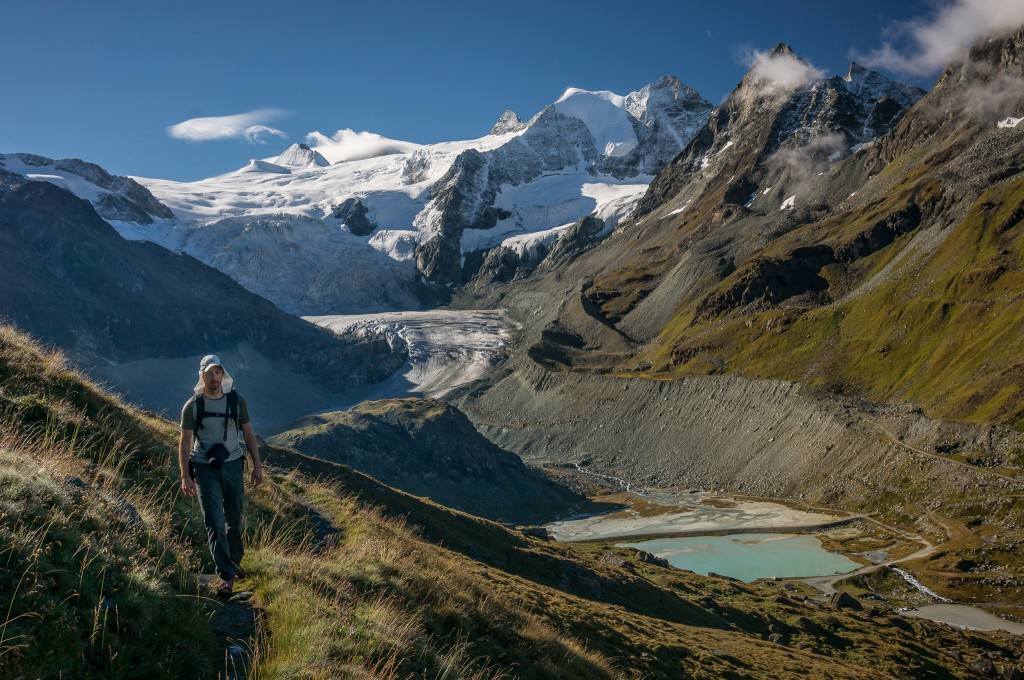
(photo by Anne Archambault)
We traversed along the trail, taking in the incredible views down the valley towards the dam and the even more incredible views back up the valley to the glacier, hut, and mountain peaks. Below us the glacial lake was a brilliant turquoise in color. Above, the careful eye could make out both ibex and chamois moving about the rocks.
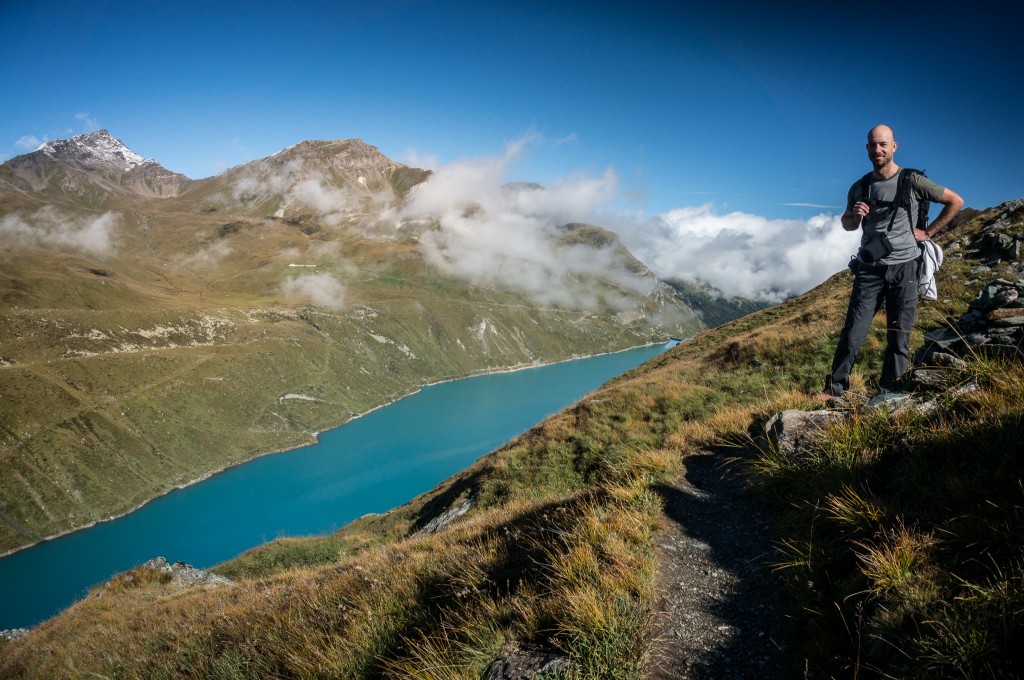
(photo by Anne Archambault)
The trail traverses to just above the dam at the end of Lac de Moiry before climbing, slowly switch backing along a road at first and then much more directly, up to the Col de Sorebois. As we reached the col, we found that while our side of the pass was very much in sunlight, the other side of the pass was completely obscured in fog. Rather than breaking for lunch, we decided to head down and hope for better weather lower down.
It wasn’t long before breaks in the clouds rewarded us with some pretty incredible views of the mountains waiting for us on the other side of the valley. As Anne pointed out the small break in the clouds, I gasped with amazement at the jagged peaks emerging from the whiteout.

The descent from the pass was relatively non-descript. We hiked along a path that at times was a two track road servicing the ski area and others a small trail that cut between switchbacks in the road. Ski lifts crisscrossed above making the place feel more urban than most of what we’d experienced along the way. We descended to the Sorebois cable car station where we grabbed some seats on the deserted terrace and had lunch overlooking the valley below us.
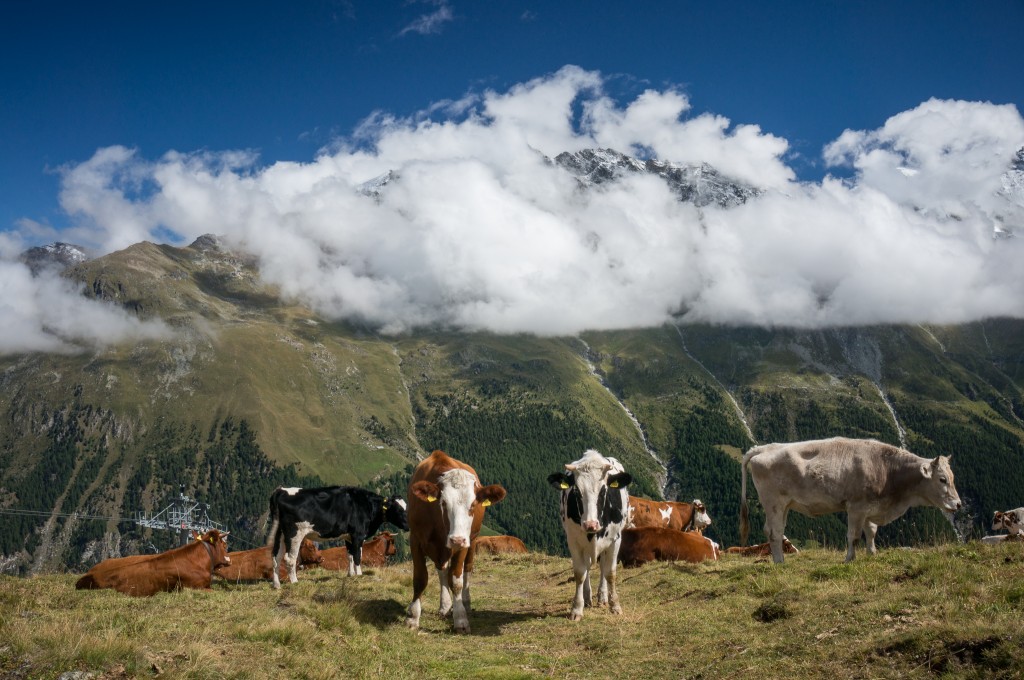
(photo by Anne Archambault)
The rest of the path down was a grunt. The trail switchbacks in open meadows at a relatively aggressive grade before entering trees and heading almost straight down the mountain. There are few trails I’ve been on that have been so tiring on the descent and I was very glad to have my poles to steady my walk and help preserve my knees. After what felt like hours the trail finally leveled out near the base of the valley and traversed above the river to a bridge where we finally crossed into town.
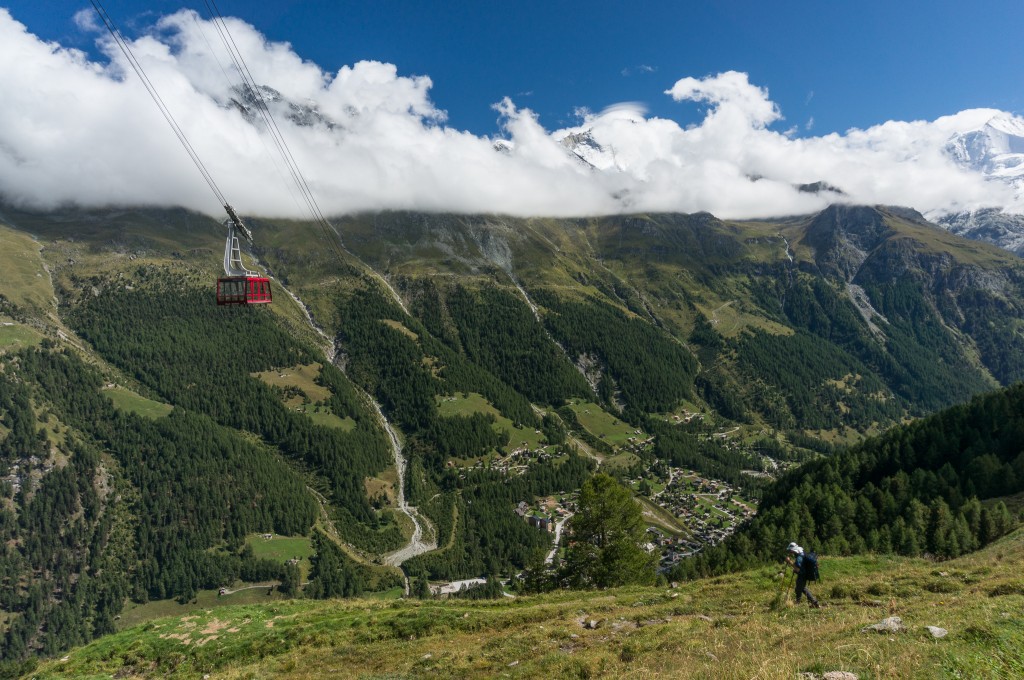
(photo by Anne Archambault)
Zinal is a sizable village with an ATM, restaurants, a couple grocery stores, and a collection of outdoor and gear shops. The hotels here were reasonably priced and provided bus passes for transit up and down the valley should the need arise. Anne and I were happy to have a little extra time during the day to wash clothes, enjoy the warmth of the sun, and relax.
Since we weren’t sure who among our party was going directly to Gruben versus Hotel Weisshorn, we organized dinner at the Hotel Europa where all of our travelling friends got a table together and enjoyed what we hoped would not be our last evening together as a group.
Max elevation: 9328 ft
Min elevation: 5446 ft
04
2014The hike from La Sage to Cabane de Moiry counts as probably the second hardest day of the trip behind the long and tiring traverse from Cabane du Mont Fort to Cabane de Prafleuri. On paper, this stage of the trip shares the title for largest elevation gain and the hike lived up to that hype. To make matters more intimidating, the weather forecast called for 90% chance of rain.
Because of the big day ahead of us, Anne and I got started as early as we could, taking first call at breakfast and shoving off before 8am. We’d both taken the hint from the weather forecast and started with rain pants and pack covers on. I was glad my rain pants had full length zips because it wasn’t long before I was getting warm and looking to dump excess heat as we climbed steeply up the valley walls towards the Col du Tsaté.

(photo by Anne Archambault)
It’s worth noting that most of the trail from Chamonix to Zermatt passes through summer pasture land. However, nowhere on the Haute Route was the evidence of cows more present than in the climb from La Sage up to Col du Tsaté. In places, it was almost impossible to walk without stepping in cow pies. This got us into the habit of identifying such parcels on the trail and calling out “Caca Suisse!” to avoid stepping in them.
The descent from the col led to a pronounced flank along the valley, likely an old moraine, from which there was a steep descent to the lake and, um, parking lot. That’s right, you can take a bus here and in the summer there’s even a refreshment stand. Anne and I grabbed a bench and made lunch while we looked at other tourists who’d driven up to the parking lot for a picnic. It wasn’t long before Val, Kathy, Eliza, and Gareth joined us and we had a great lunch before heading off and up again to the hut.
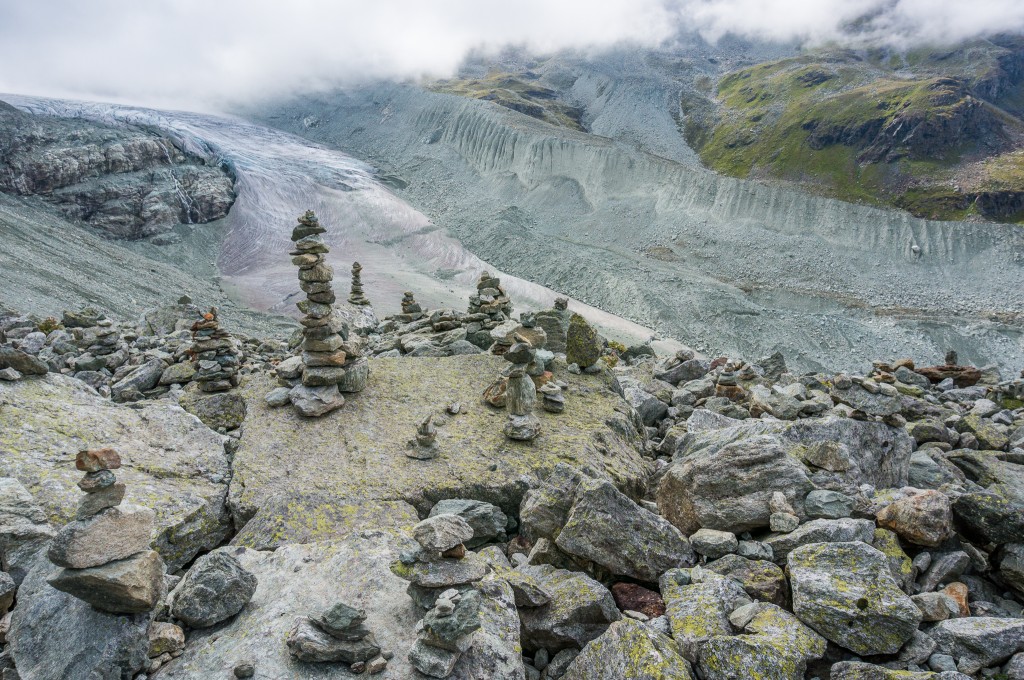
(photo by Anne Archambault)
The final part of the day involved a hike up from the parking lot to gain the crest of the lateral moraine running up the valley. This then descends off the moraine and over to the valley wall where it again climbs steeply in switchbacks until it finally gains a stupendous overlook and the Cabane de Moiry. Alas, most of our hike was in low clouds obscuring the view up the mountain and threatening rain. Combined with the already large dose of elevation gain, it turned the final part of the hike into a chore.

(photo by Anne Archambault)
Without a doubt, Cabane de Moiry was the highlight of the trip for me. The hut sits atop an incredible viewpoint and has windows that stretch floor to ceiling and provide unmatched views across the glacier to the mountains towering over them.
From the hut it’s possible to access a myriad of rock climbs as well as glacier travel, advanced mountaineering, and ski touring in the winter. Our entire entourage was happy to sit back, read, drink beer, and enjoy this wonderful setting. As a bonus, we were even able to see ibex while we were eating. Truly a glorious setting and a highlight of the trip!
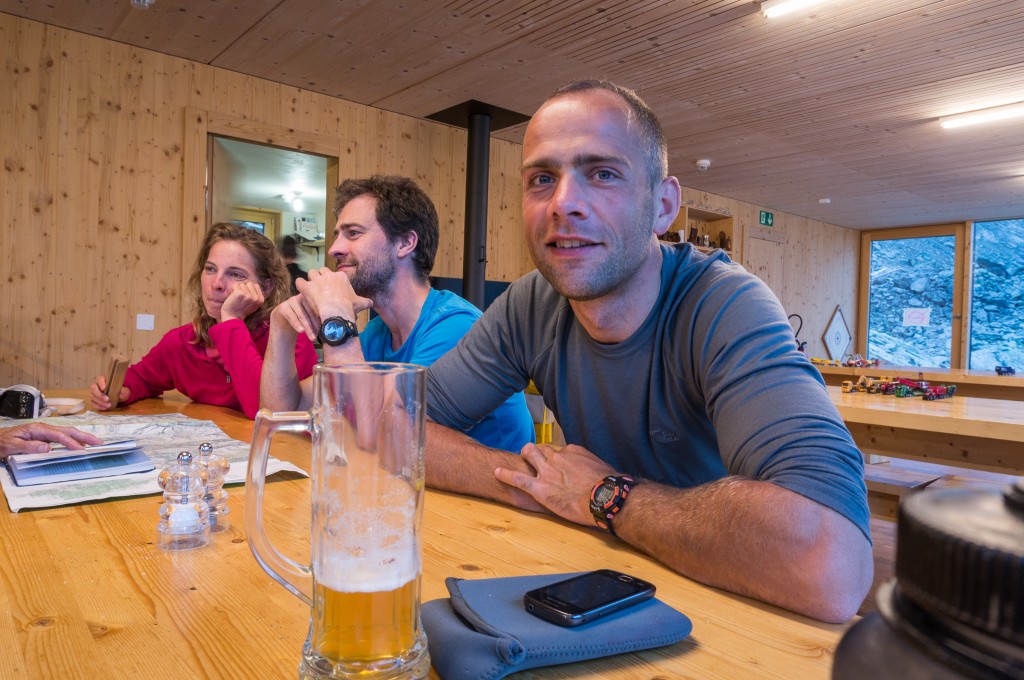
(photo by Anne Archambault)
Max elevation: 9401 ft
Min elevation: 5405 ft
01
2014The stage from Arolla to La Sage is probably the most poorly described stage in the guide book. While this stage reads like a “rest stage” as you walk down the valley from Arolla to Les Haudères with 215m of elevation gain covered in 4 hours, we in fact gained about 2000 feet of elevation as we climbed out of Arolla and traversed above the valley floor to Lac Bleu in a total of 6 hours. Anything but the day we had been expecting!
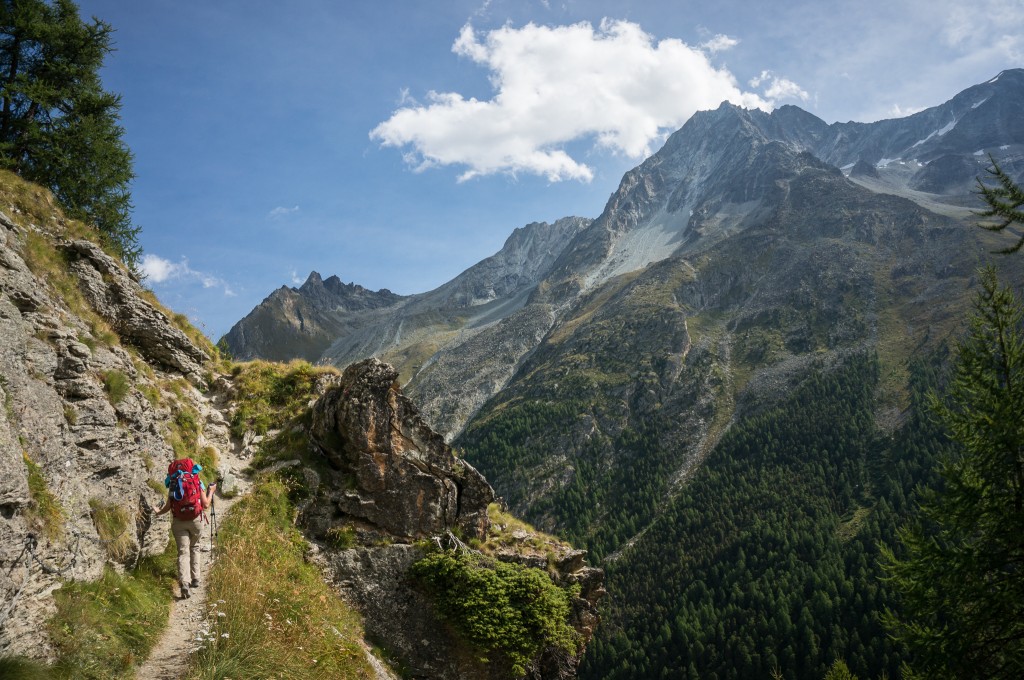
(photo by Anne Archambault)
To make the day more exciting, Anne and I chose the “harder” of the two paths to Lac Bleu leaving from Arolla and climbing steeply away from the village and above the valley below. As described in the guidebook, this trail had several sections with chains that we hoped would lead to some exposed sections with grand views. However, it was largely a letdown as most chain-protected sections were really quite safe hiking except perhaps in freezing conditions.
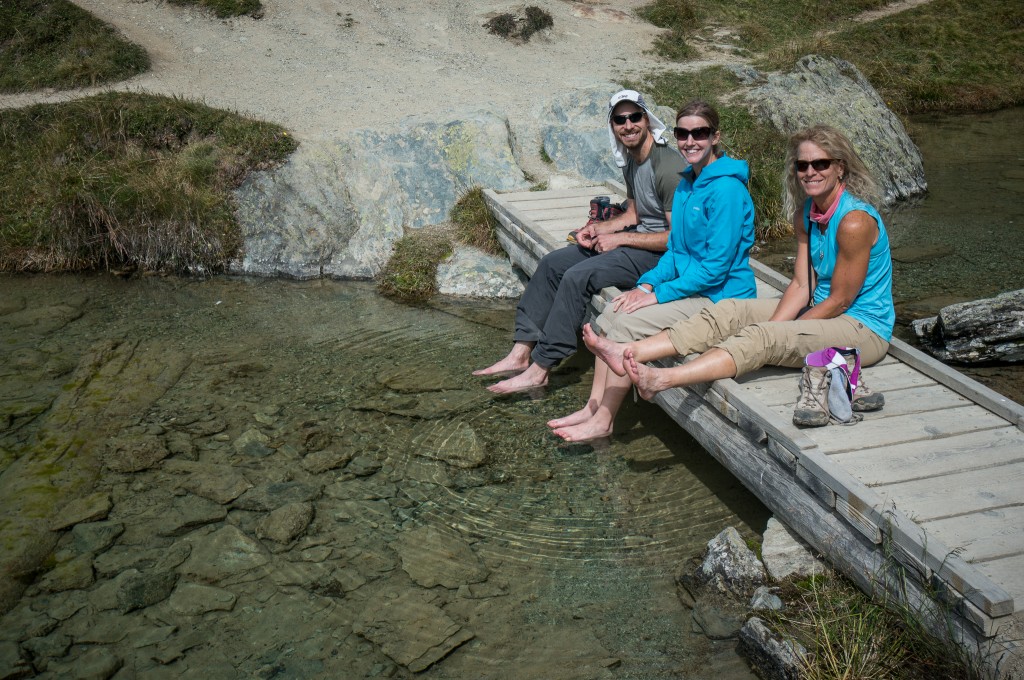
(photo by Anne Archambault)
Elevation was gained steeply out of Arolla, which then turned into a traverse along the valley. This traverse steeply gained and lost elevation constantly until we reached Lac Bleu, the final high point on the path before descending to Les Haudères. Lac Bleu is the highlight of the stage with an incredible vista over the valley combined with a surreal blue hue. We took time to eat lunch and dip our feet in the cold lake.
Leaving Lac Bleu you immediately come to some old buildings where we should have turned right and headed steeply down towards La Gouille. Instead, we continued along our traverse following signs towards Evolène. We soon realized that the trail we were on continued down the valley but in the wrong direction and away from Les Haudères. The mistake was easily corrected; we joined a trail leading back to La Gouille and turned back around, only losing about 15 minutes time on the detour.
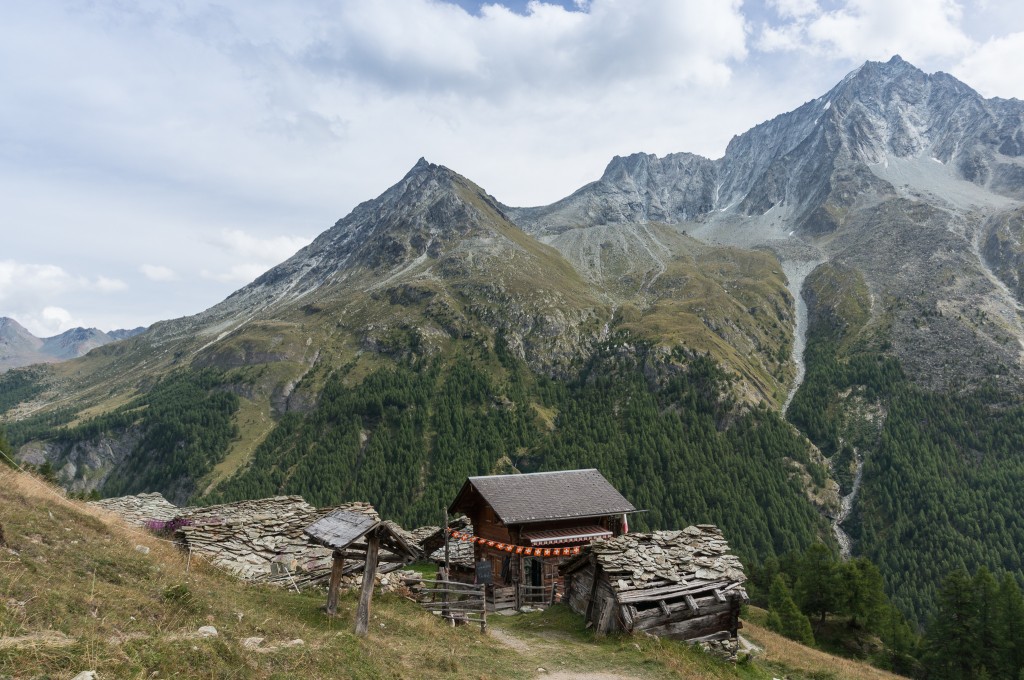
(photo by Anne Archambault)
From La Gouille, the trail dips below the road and towards the creek on the east side of the valley, falling rather steeply down to Les Haudères on a generally shaded two track road. In Les Haudères, we grabbed lunch, rested, and restocked our supplies for the next couple days.
I’ll make a call out for the local Les Haudères tomme cheese. Hikers should note that most of the villages along the way make town or valley specific cheeses. The tomme in Les Haudères was probably the finest of the trip. If you do pass through town, don’t miss out on this fantastic cheese!
Supplied up, we joined back with the trail to La Sage which climbs out of Les Haudères and gains 200 or so meters of elevation quickly to La Sage. Here Anne and I came across a pair of farmers with a small boy. They’d apparently been gathering fire wood when they managed to turn their tractor over on the path. I dropped my pack and tried to help them get the vehicle upright. Gareth, Val, and Kathy soon joined us and despite having the additional horsepower, we were completely unable to get the tractor right side up. Despite our lack of success, the farmers were grateful for the help and thanked us as we put our packs back on and headed the last short bit to the hotel.
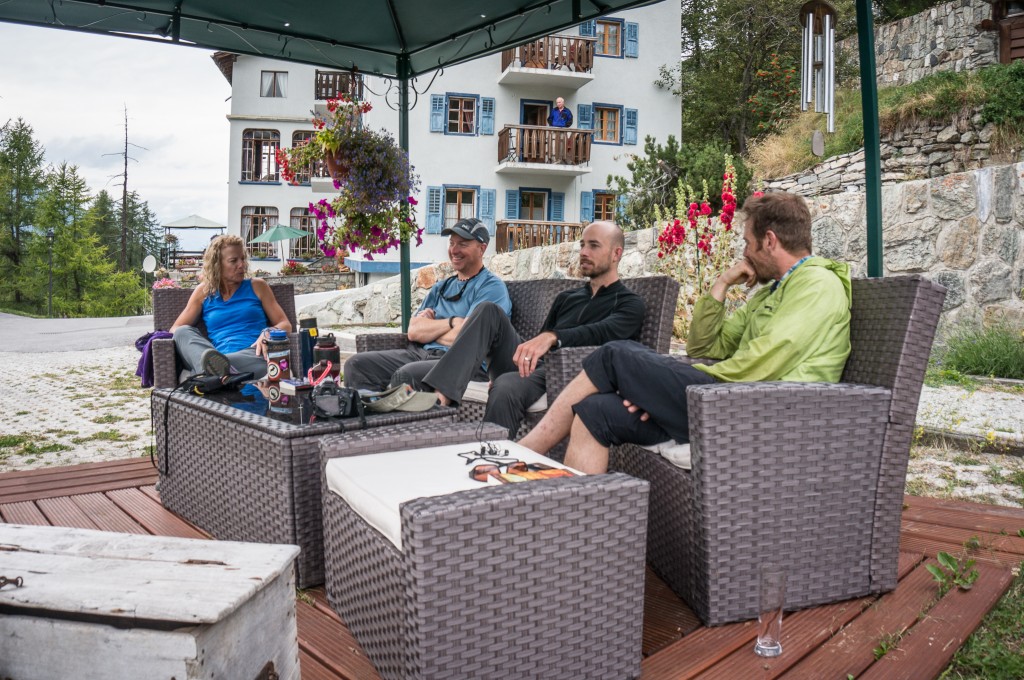
(photo by Anne Archambault)
The Hotel De La Sage is one of two places you can stay in La Sage. We’d booked our rooms the previous night at dinner in Arolla and were lucky enough to secure rooms for everyone in our party. In terms of hotels, Hotel De La Sage easily takes the prize for being the nicest hotel we stayed at during our entire visit. Inside the rooms had been recently renovated and were very modern both in conveniences like outlets as well as in style.
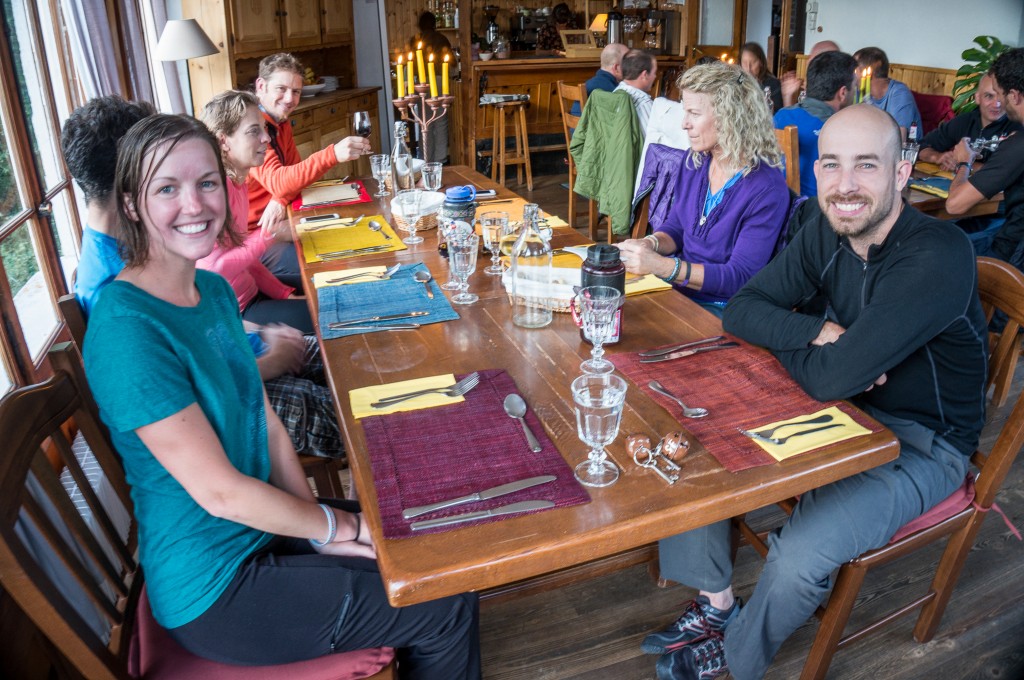
(photo by Anne Archambault)
The included dinner looked like something out of a foodie gastropub. We had salmon tartar as an appetizer, duck breast as a main course, and we finished with an outstanding cheesecake.
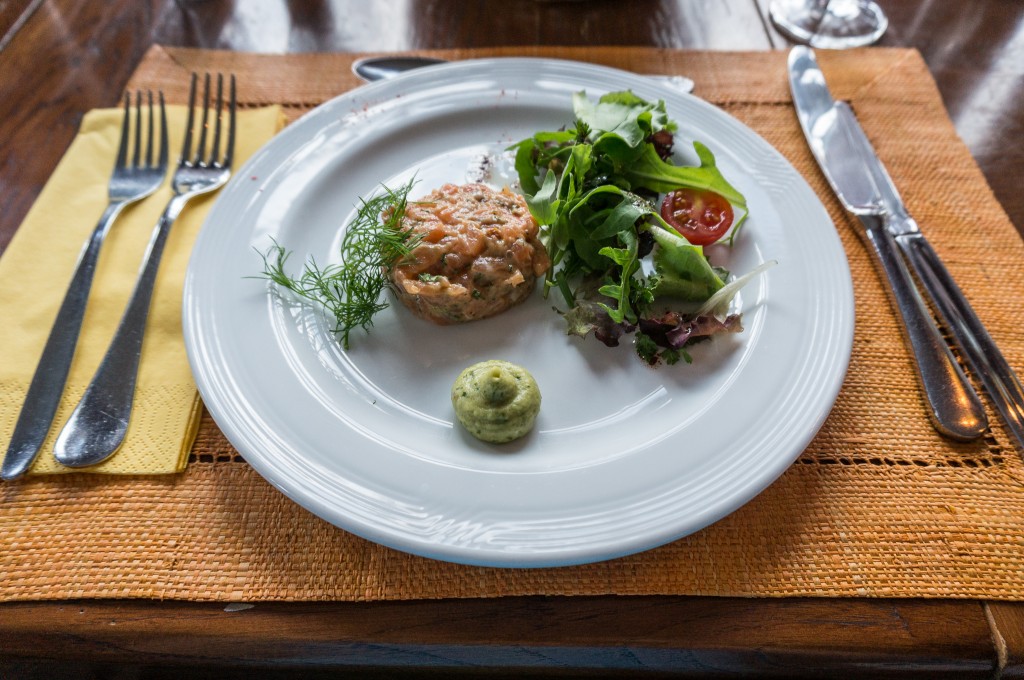
(photo by Anne Archambault)
Max elevation: 6998 ft
Min elevation: 4639 ft
30
2013The stage from Cabane de Prafleuri to Arolla is arguably the most beautiful stage of the entire walk from Chamonix to Zermatt. The day starts with a short climb up to the Col des Roux which opens into beautiful views over Lac des Dix and up the valley towards Mont Blanc de Cheilon. The morning light over the valley was incredible and Anne and I quickly fell behind the other groups as we took pictures.
The trail worked its way gradually down to about 100 feet or so above the level of the lake where we met up with the rest of our traveling buddies and traversed along a road to the lake’s south end. Marmot dotted rocks along the hillside, sunning themselves in the morning light. This area is also open pasture so we shared the path with a fair number of friendly cattle.
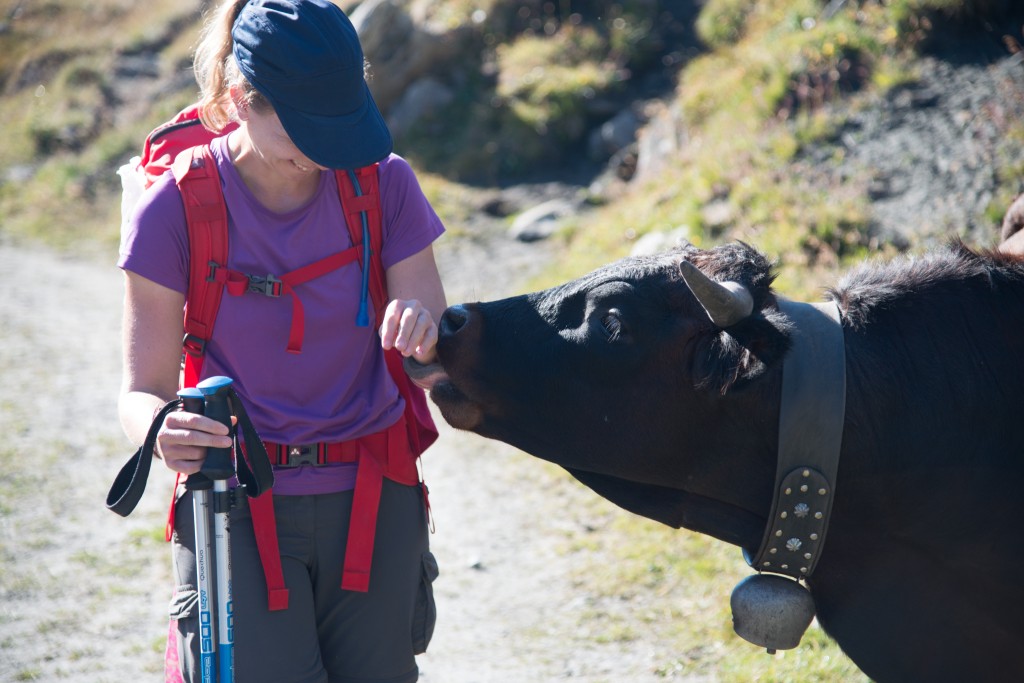
At the south end of the lake the trail climbs steeply away from the lake and up a valley that quickly turns into a glacial moraine. The remains of the old Cabane des Dix are passed some 15 minutes after leaving the road, which serve as a testament to how long mountain huts have been a part of the culture as well as a reminder of a time when the glaciers were larger and more prominent.
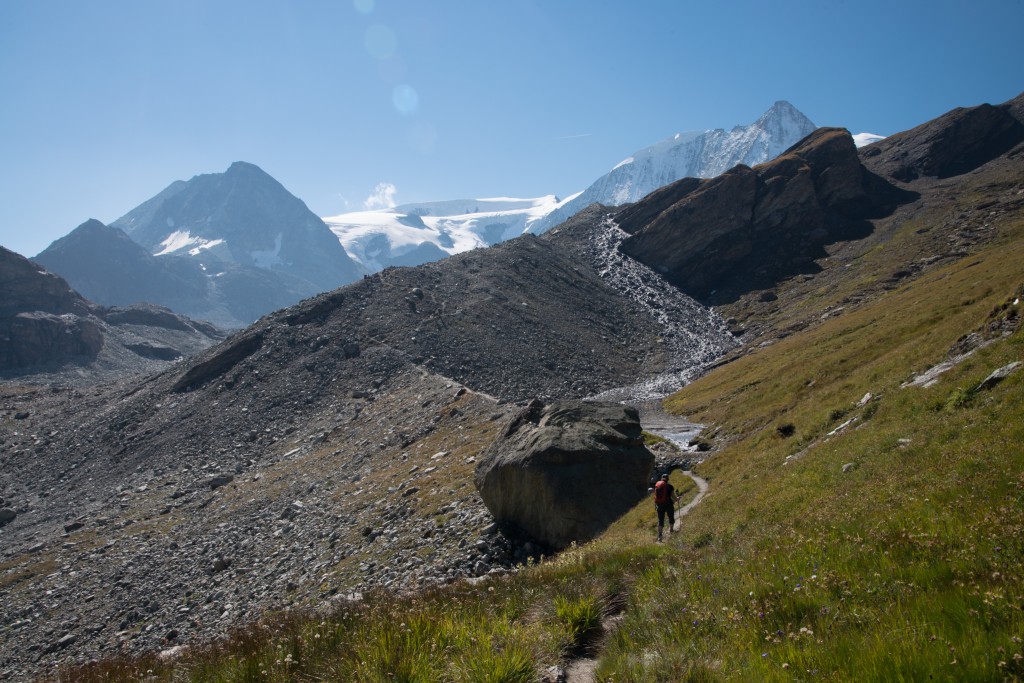
From the old hut, the path climbs steadily until it reaches a junction where the path forks. On the left the path leads directly to the col and on the right the path continues to climb up the moraine towards Cabane des Dix. We continued right in search of grand views up the valley over Mont Blanc de Cheilon and a peaceful lunch on the hut’s patio.
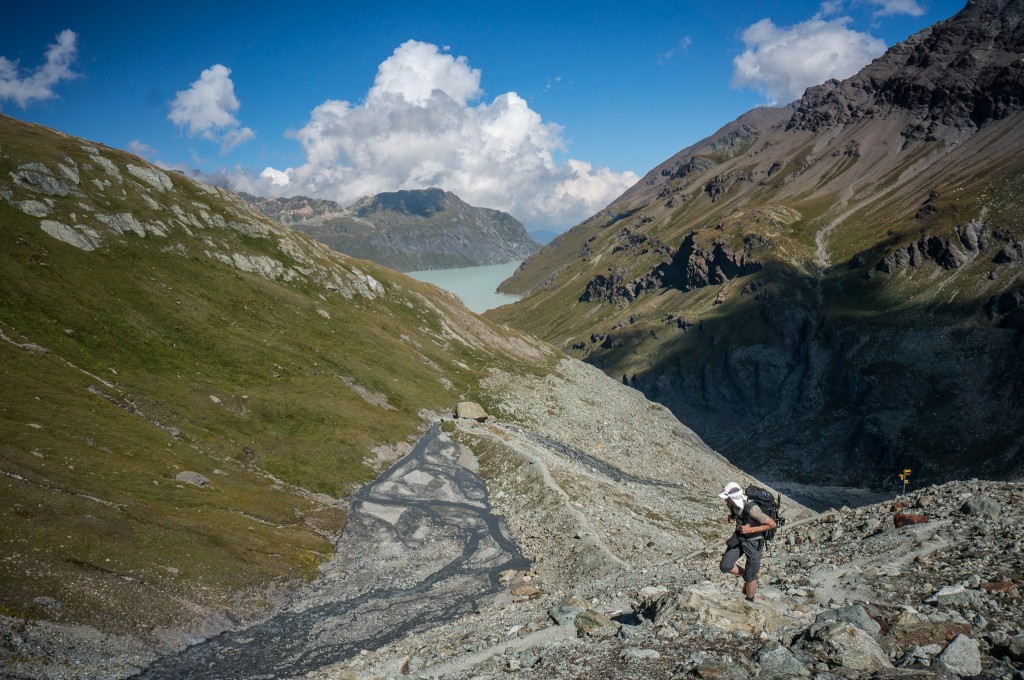
(photo by Anne Archambault)
Continuing up and along the moraine, views over the glacier opened up and we could easily see the other path crossing below the glacial snout, the path over the col, and the notch indicating the upcoming ladders at the Pas de Chèvres.

(photo by Anne Archambault)
I found the last section of the hike to Cabane des Dix to be deceiving because it involved a lot more climbing than I’d imagined. From the moraine, the path drops right across a small ravine and then climbs steadily around a blind corner that reveals another 200 feet or so of elevation gain to a ridge that marks the high point for the day. Upon gaining the ridge we got our first glimpse of Cabane des Dix as well as excellent views over Mont Blanc de Cheilon and associated glacier. Here I stopped to take a panorama while Anne continued on towards the hut and a well-deserved lunch.
After lunch our path took us down and across the glacier to the other side of the valley. Normally glacier crossings are only to be done with rope and proper equipment. However, this particular crossing is across firm ice and lacks the crevasses and snow bridges that typically mark dangerous conditions. A route is well established across the glacier and is marked by cairns and a decent foot path.

(photo by Anne Archambault)
After climbing a short distance up the moraine and away from the glacier, the trail traversed several hundred meters of scree to rejoin the original trail leading to the Col de Reidmatten. This in turn climbed another 150 feet or so before splitting off yet again and traversing over to the ladders at the Pas de Chèvres.
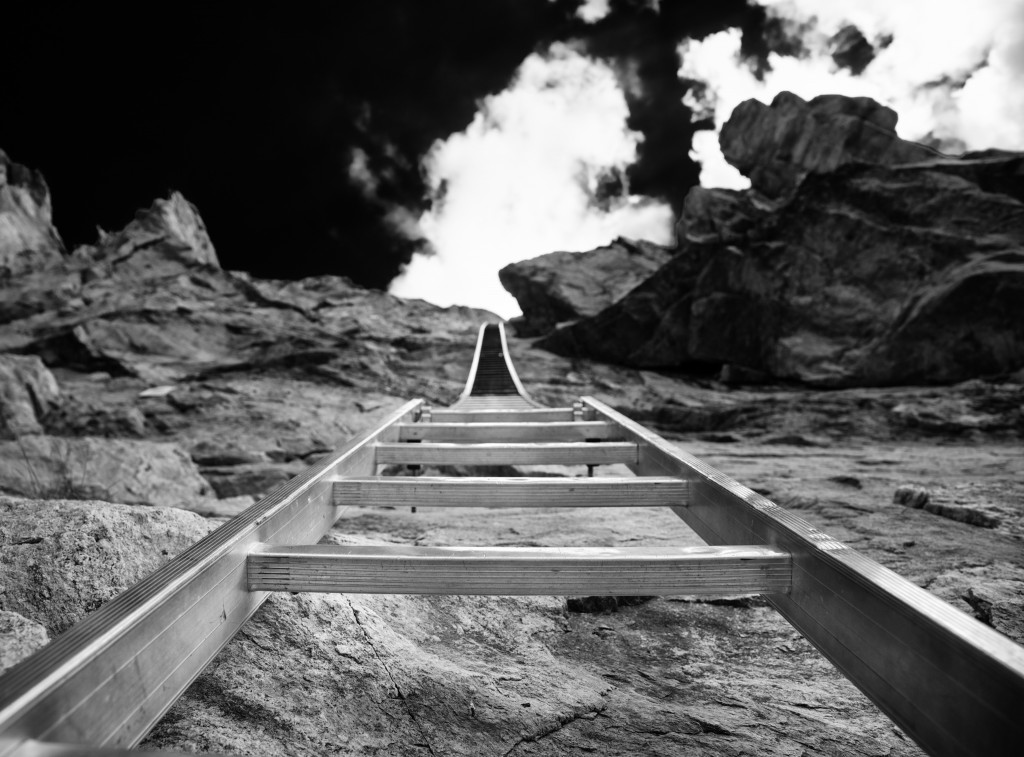
For Anne and myself, the ladders at the Pas de Chèvres were probably the highlight of the hike. The ladders climb almost vertically for about 30 feet, sidestep 4 feet, and then continue about another 15 feet before topping out at the pass. The climb up the ladders was surprisingly tiring, not helped by the fact that each of us was carrying a loaded pack.
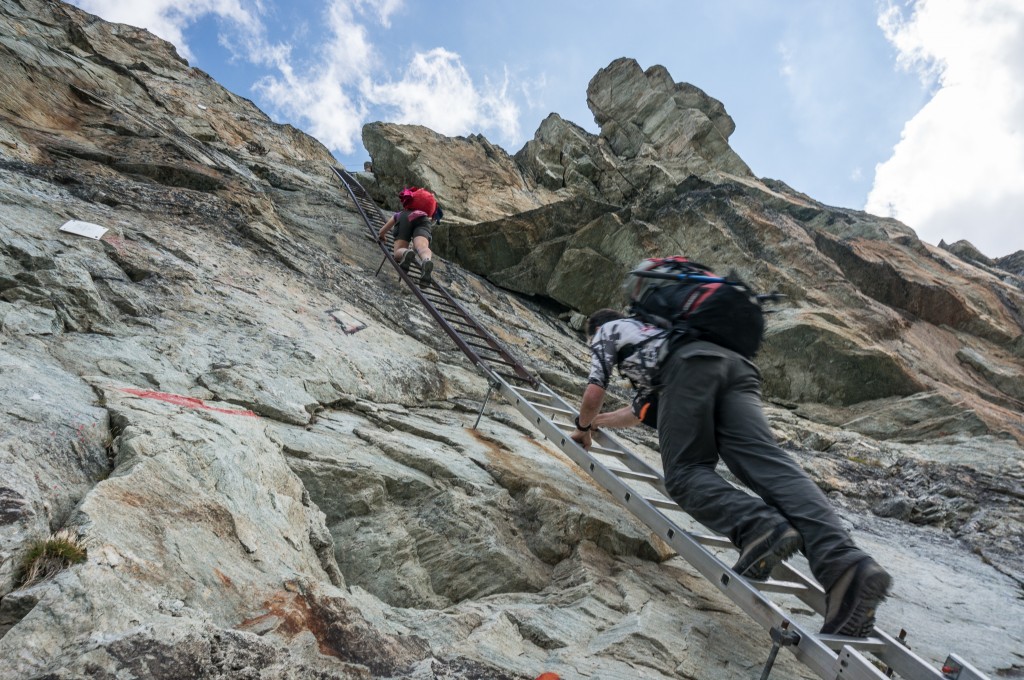
(photo by Anne Archambault)
Rich, who had some climbing gear, was nice enough to climb up and tie himself in so he could take photos as we climbed.
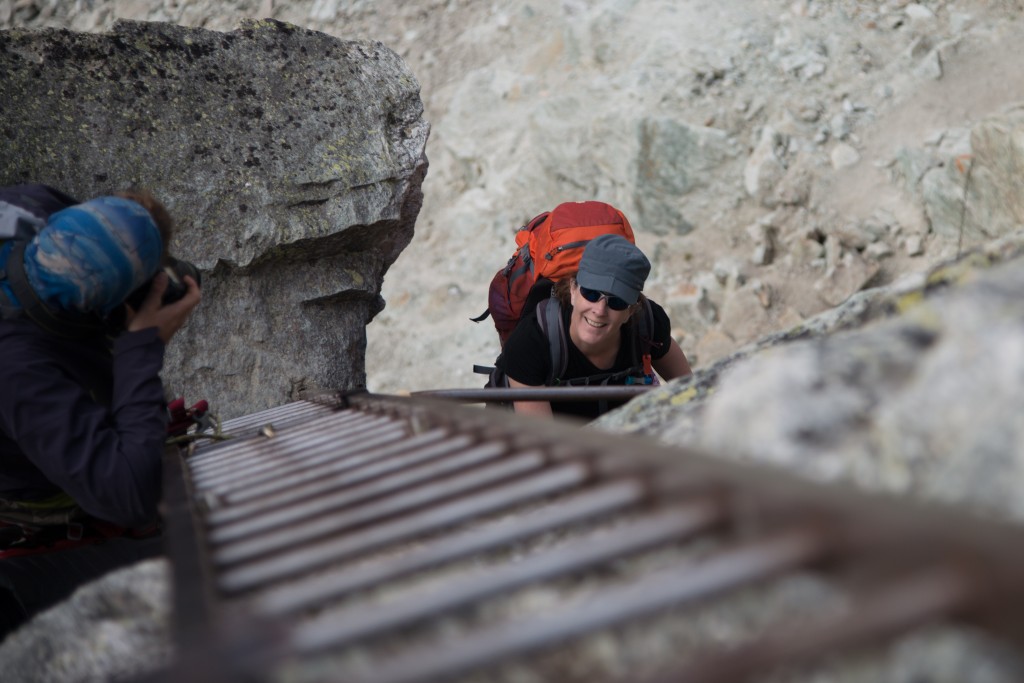
Each of us, in turn, climbed up to the top with resultant cheers and high fives as we topped out and looked out over the glacier below. Once all at the top, we gathered for a group portrait while taking a short break and celebrating the final uphill portion of the day before the long downhill hike to Arolla.
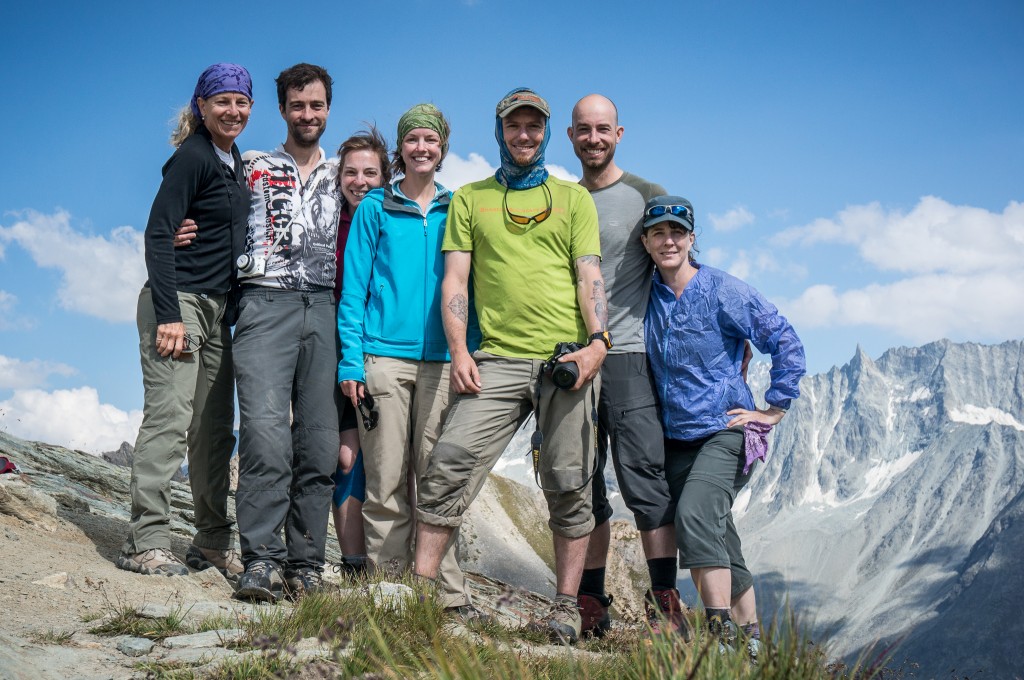
The hike down to Arolla was generally well graded and traversed across open alpine terrain and ski slopes before heading down a steep set of switchbacks into the trees and finally into Arolla itself.
Since we didn’t have advance reservations, we stopped by the tourist office and inquired about hotels, pricing and availability. We settled on the Hotel de Mont Collon after the woman at the tourism office remarked about how nice and “romantic” the hotel was with all the “tapestries” it had. On hindsight, we might have been better served with another hotel since the Hotel de Mont Collon was more worn down than romantic and the rooms had a tired feel to them. The hotel was also located below town and hence below the next day’s trail head, which required us to hike back uphill to start our day.

(photo by Anne Archambault)
For dinner, we all decided to head back up into the heart of town where there were some limited dining options. We settled on a restaurant that had raclette on the menu, which was something that Anne and I had been excitedly waiting to eat. Raclette is a traditional Swiss dish that involves placing a wheel of raclette style cheese near a heating source, scraping that cheese off onto a plate, and then service with cooked potatoes and pickled pearl onions, gherkins, and sometimes meat slices.
We enthusiastically got some of our friends to try this cheese dish, which in this case was served by the hostess who would ferry plates back and forth to the heated cheese and with bread, potatoes, gherkins, and pickled pearl onions. The meal was exceptionally filling and I certainly went to bed knowing I wouldn’t be wanting for calories on the following day!
Note: While Arolla may seem like a large town from descriptions in the guide book, it does not have an ATM machine. You can withdraw money at the Tourism Office, but they will charge you an additional fee for the service. In fact, the next closest ATM machine is in Evolène down the valley several hours by foot and a detour from the path.
Max elevation: 9762 ft
Min elevation: 6493 ft
11
2013When travelling from Cabane du Mont Fort the hiker is faced with a couple different route options. The more direct route, and also the one that’s recommended when weather is uncooperative, goes via the Col de la Chaux. The longer and more scenic route traverses above the valley floor and provides wonderful views of the Combin massif before traversing across three passes on the way to Cabane de Prafleuri. Since the weather report was good we chose the longer and more scenic option along with the rest of our travelling companions (and the rest of the overnight residents of the hut).
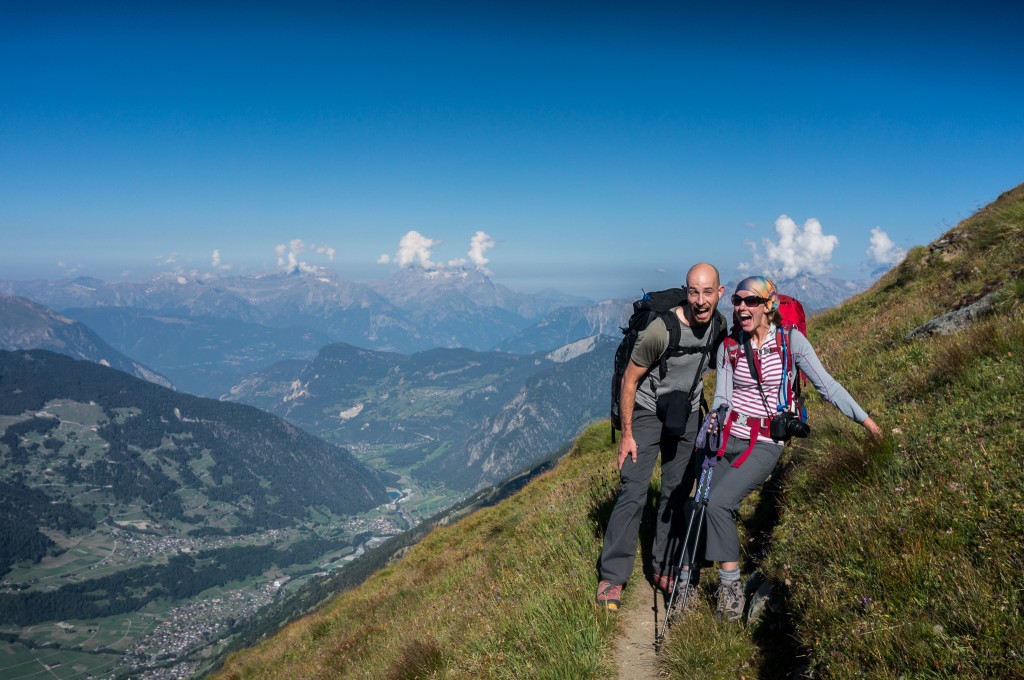
The path from Mont Fort initially drops down a couple hundred feet before starting a slowly climbing traverse that gently levels out and continues all the way to Col Termin. This section of the hike was spectacular with wonderful views up and down the valley as well as across the valley to the Combin massif. The trail was crowded with hikers, all of whom were stopping frequently to take pictures of the wonderful scenery. Several sections of the trail had chain handholds, though I never felt like I needed them or was in any danger of falling.
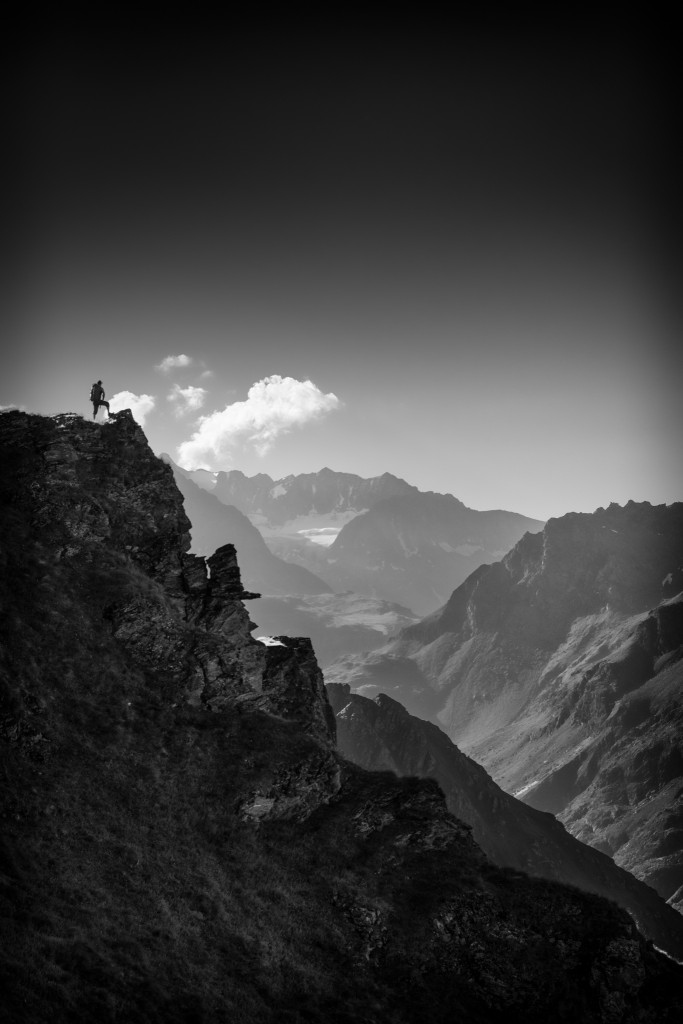
We all reached Col Termin in good time and enjoyed a snack while basking in the warmth of the sun. To say it was all glorious would be an understatement.
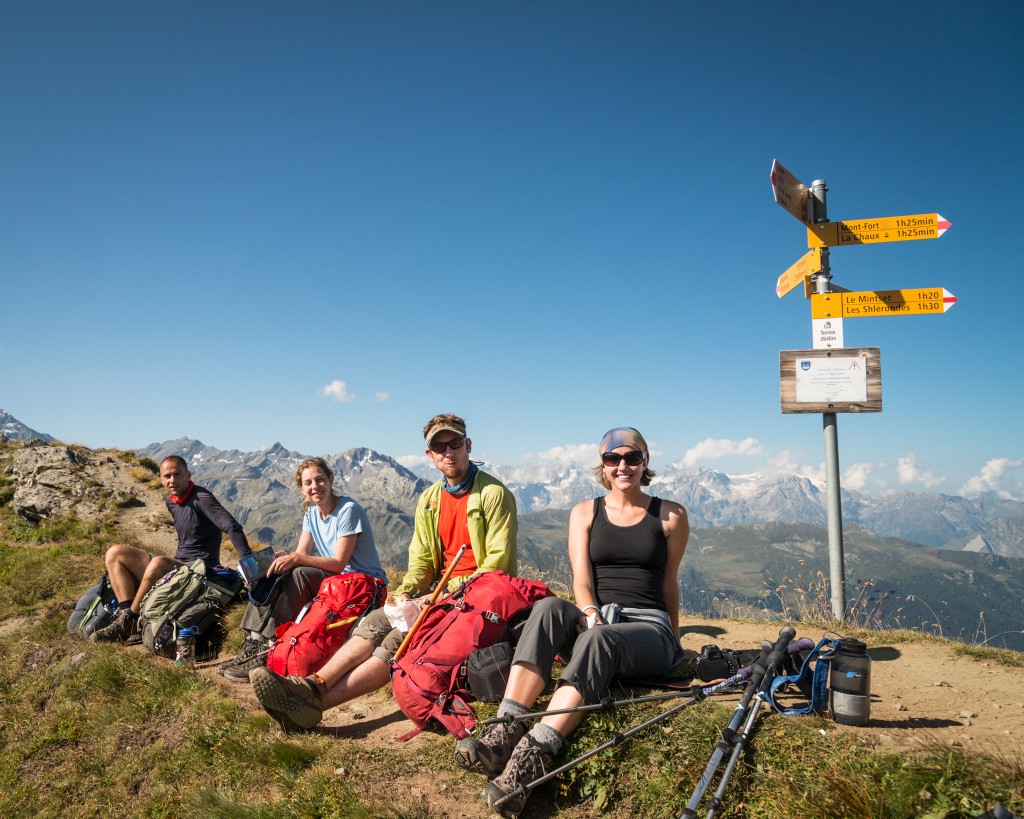
The path from Col Termin to Col de Louvie follows a nice traverse up the valley before climbing steeply to the col. Based on the elevation profile in the book I’d prepared myself to drop all the way to the valley floor and then climb back to gain the col. Thankfully, this wasn’t the case at all as our elevation loss was limited to probably less than 100 feet. However, this section of the hike took longer than expected, partially due to the up and down and partially because the last part of the climb to the col was quite steep.
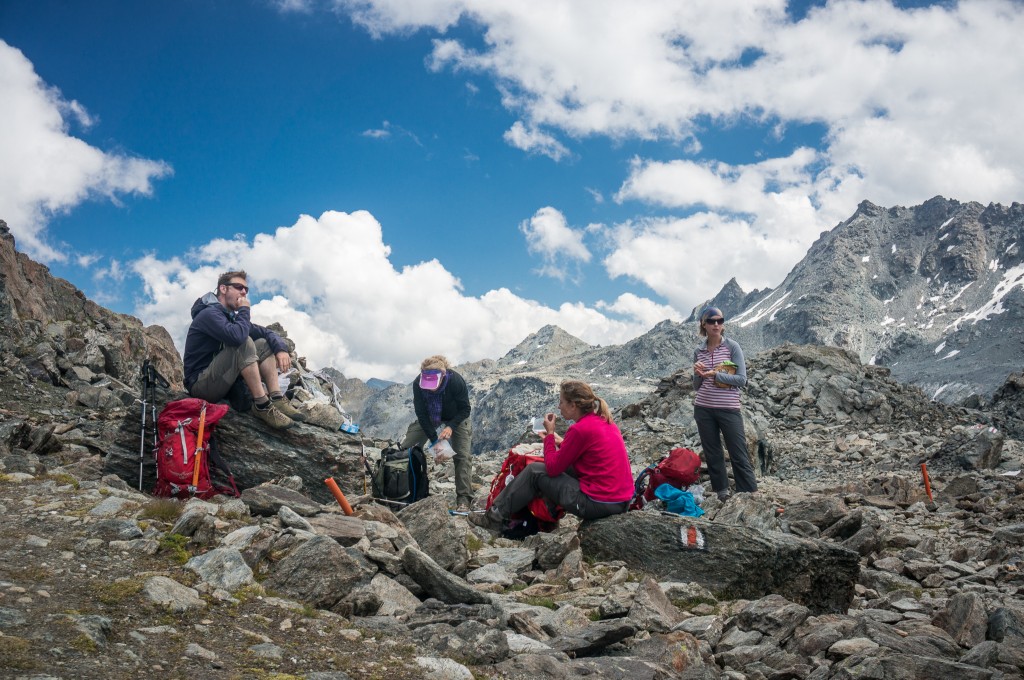
We all ate lunch at the col, by which time the sun was clouded over and the peaceful warmth we’d enjoyed at Col Termin was replaced with a brisk wind and a slight chill. Lunch was our staple of bread and cheese, with some potato chips and mixed nuts. It was refreshing and helped us recharge from the morning hike.
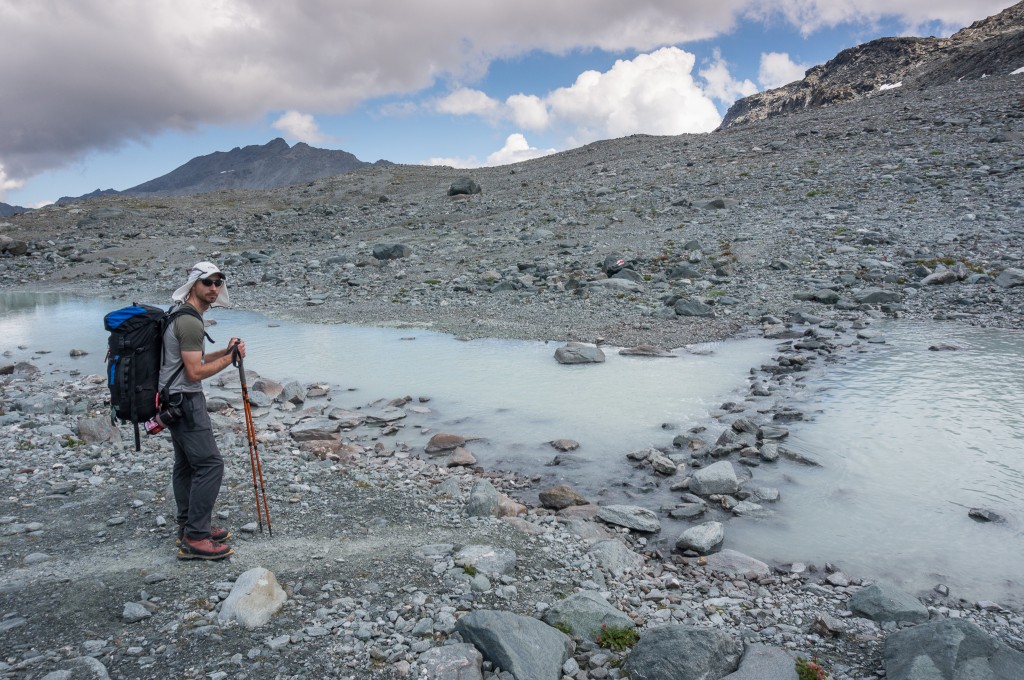
Looking out from the col the hike lead across the aptly named Grand Desert. This alpine valley is a wasteland left behind by a retreating glacier. It’s virtually devoid of life and could easily be a landscape from the moon. The path from the col leads steeply down towards the valley. On the way down, the guidebook suggests taking note of a very large painted trail marker on the other side of the valley to be used as a landmark. This is especially handy because the trail becomes much less distinct after crossing the small stream.
The glacier here is in full retreat, a small shadow of its once massive self. However, glacial outflow still forms small lakes and streams that add color and texture to the landscape and provide interesting patterns in the water.

From the stream crossing, the trail makes its way steadily uphill to the large painted rock where it veers left and gains elevation steeply to a rocky bench that looks back over the valley, glacier, and Col Louvie. The trail then levels out and traverses open and rocky terrain before bending slightly right towards another valley where the trail descends almost vertically about 200 feet before beginning the last and final climb to Col de Prafleuri.
Mentally, I wasn’t really prepared for this last little valley and we both begrudged the elevation we lost as we hopped down from rock to rock. The guide book doesn’t really describe these sorts of small vertical changes but they are important to prepare for mentally so you can understand how to reserve energy and optimism. Regardless, we pushed on and were soon making the climb to the final col before reaching our hut for the evening.
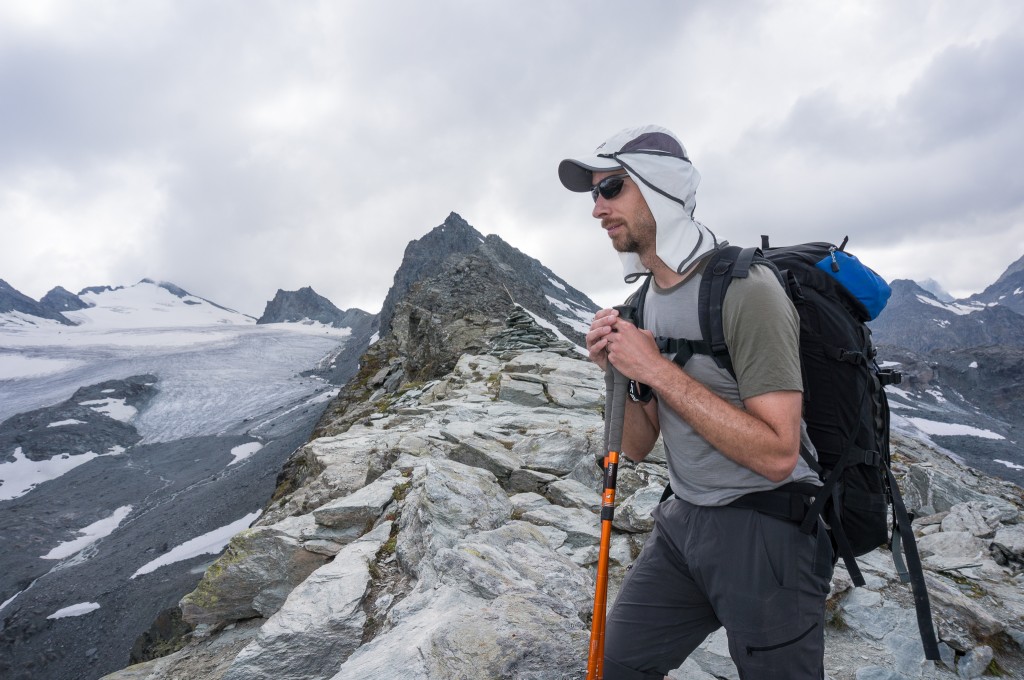
As we reached Col de Prafleuri, we found it to be rather crowded with the several groups who had set out that morning from Cabane du Mont Fort. This proved to be rather fortuitous since they pointed out a pair of ibex sitting on the hill no more than 100 yards away. I’d previously expected that I would be able to spot ibex rather easily, but these two blended in with the surrounding hillside so perfectly I would have never seen them unless they’d moved.
Anne and I recovered, snacked, and watched the ibex for some time before setting out for the final short leg to Cabane de Prafleuri, which we could see in the distance. The trail from the col was rather steep but uneventful. In truest form, the last short pitch to the hut involved a steep grunt of a hike that left us both winded but happy to have completed a long day.
Note: For Cabane de Prafleuri there are several things that would-be guests should be aware of. First, the showers only have limited hot water. Anne and I checked in and bolted for the showers as quickly as we could. However, we both had to wait 20 minutes to shower by which time the hot water was waning. Second, there’s limited power in the building unless you want to pay to turn on the outlet in your room. Resourceful individuals unplugged heaters in the bathroom and lobby to accommodate charging their phones. Finally, the water in the hut isn’t potable. This wasn’t a problem for us since we’d brought a Steripen, but others found it to be annoying that they had to purchase expensive water for the next day’s hike.
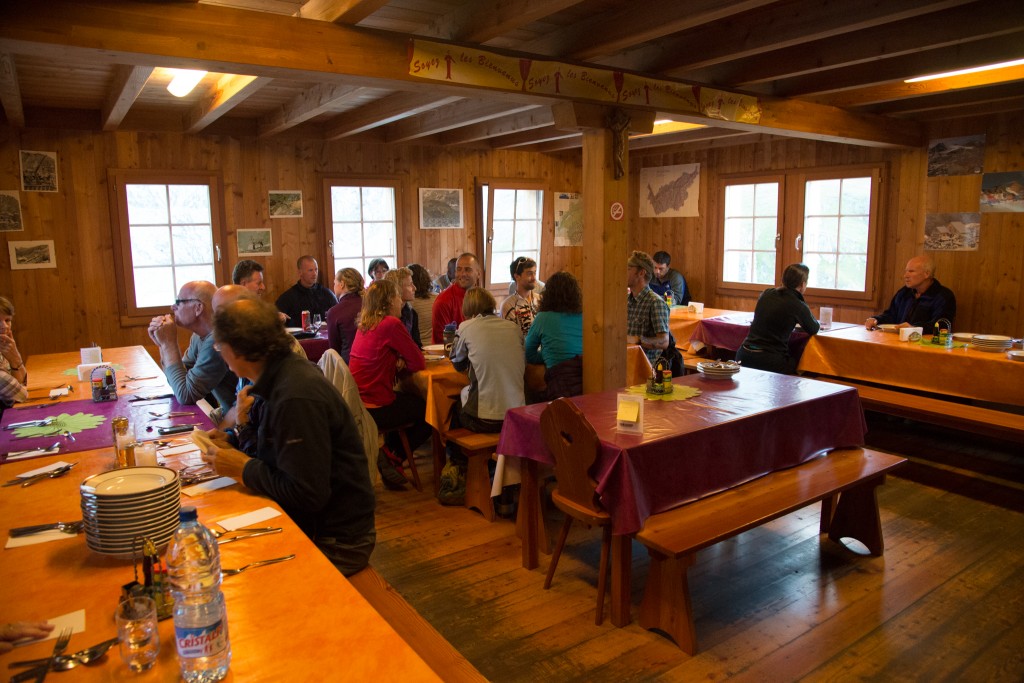
Max elevation: 9825 ft
Min elevation: 7749 ft
09
2013On paper the hike from Le Châble on the valley floor to Cabane du Mont Fort was the biggest day of the trip in terms of elevation gain. This starts the moment you step out the door of your hotel and progresses almost non-stop until you get to the cable car station at Les Ruinettes.
To ensure we made the best of the day and avoid the heat we got an early start. That kept us in the shade for most of the initial climb out of the valley. This also meant that we hiked alone almost the entire way, overlapping Martijn only briefly as he overtook us on the way up.
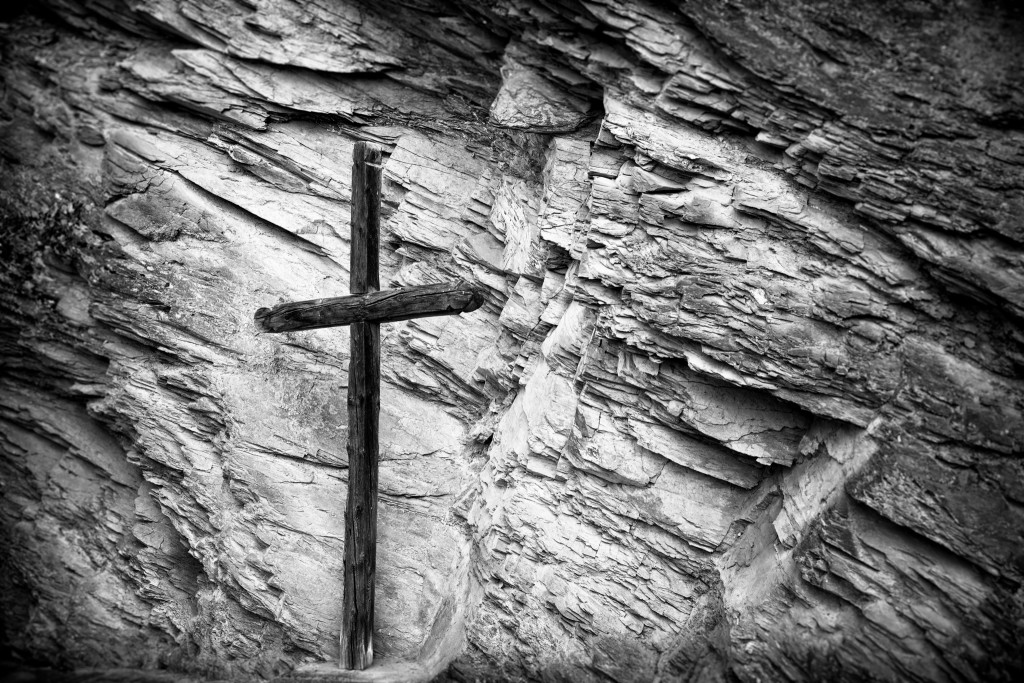
While the path was steep, it was also generally pleasant as it wound through several small villages and steeply wooded slopes. Shortly below Clambin we broke into the sun and the heat started to make its presence felt.
We stopped and grabbed water and a few bites at the junction at Clambin before continuing on up and past a small picnic area at Le Hattey and then onto a broad set of switchbacks that form a ski run in the winter. This section then diverted into the trees for the final stretch up to the Les Ruinettes cable car station.
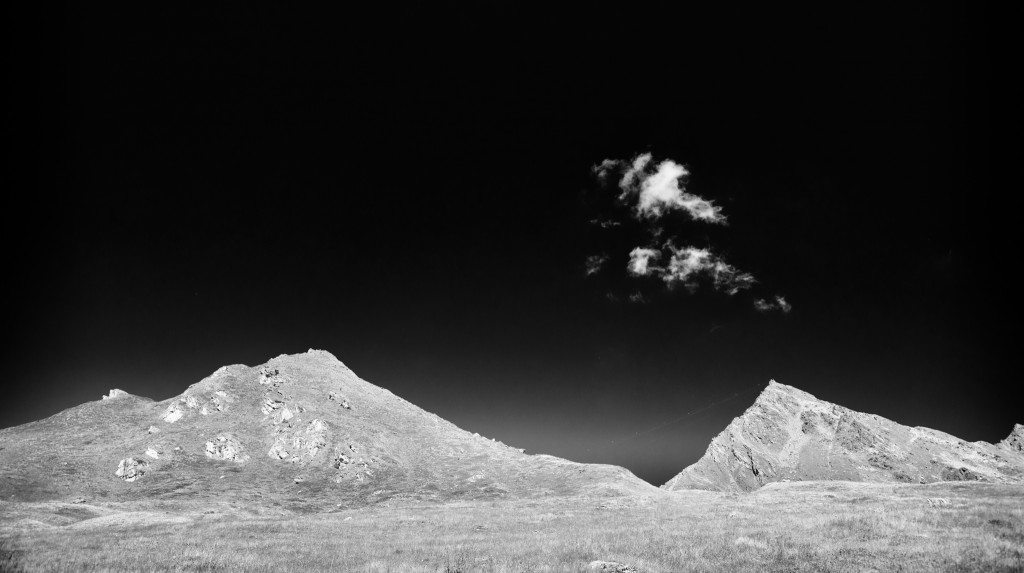
Just above Clambin the hiker’s path parallels single track mountain bike paths. This area is a mountain biking paradise and some of the runs we saw looked like they were expert or better tracks with significant jumps and features. As we approached Les Ruinettes, we saw countless bikers flying down the dirt road and splitting off onto single tracks and I wished that we’d had some time to do some mountain biking ourselves. This area was also a prime area for paragliding and as we set up for lunch at the cable car station we watch as numerous paragliders launched and soared above the valley.
After lunch we continued along towards Mont Fort. At this point, the majority of our climb was complete and the path followed the course of a bisse gently over the alpine landscape with wonderful views of the valley below and Le Châble where we’d started earlier that morning. The rest of the hike to Cabane du Mont Fort was relatively easy with a steep and tiring section completing the day just below the hut itself.
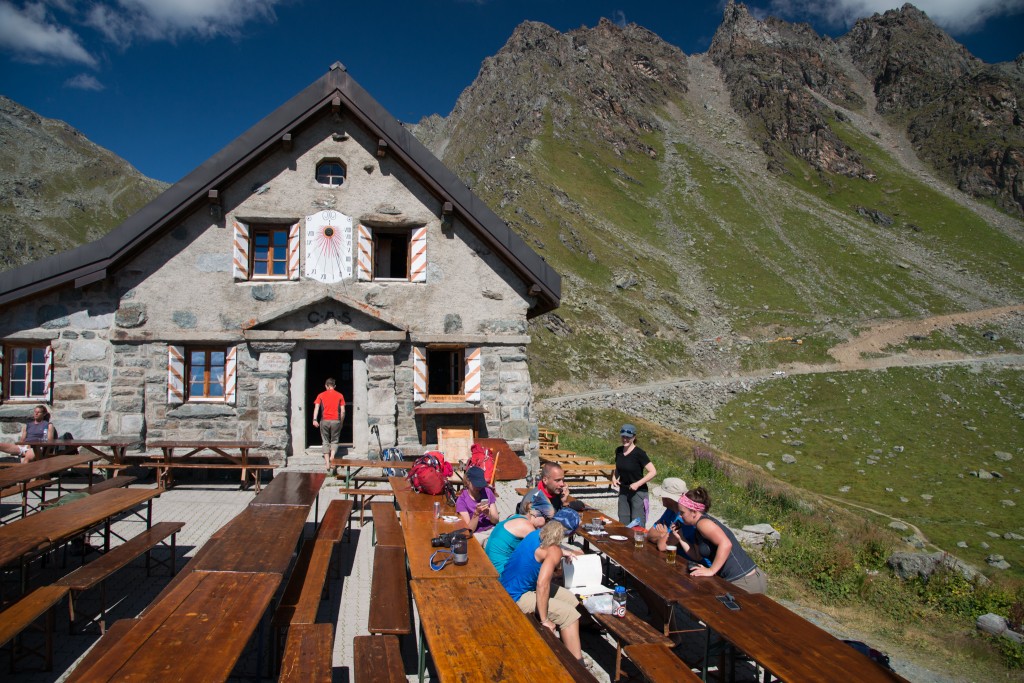
At the hut, we met up with all our travelling companions. Clare and Paul had taken the cable car earlier that morning and had been at the hut for several hours. The rest of our crew, who had started shortly after us in the morning, had arrived within the previous hour (passing us while we ate). We sat our bags on the deck and relaxed, taking in the warmth of the sun and drinking beers to celebrate a hard but enjoyable day and the incredible views afforded from such a fine alpine hut.
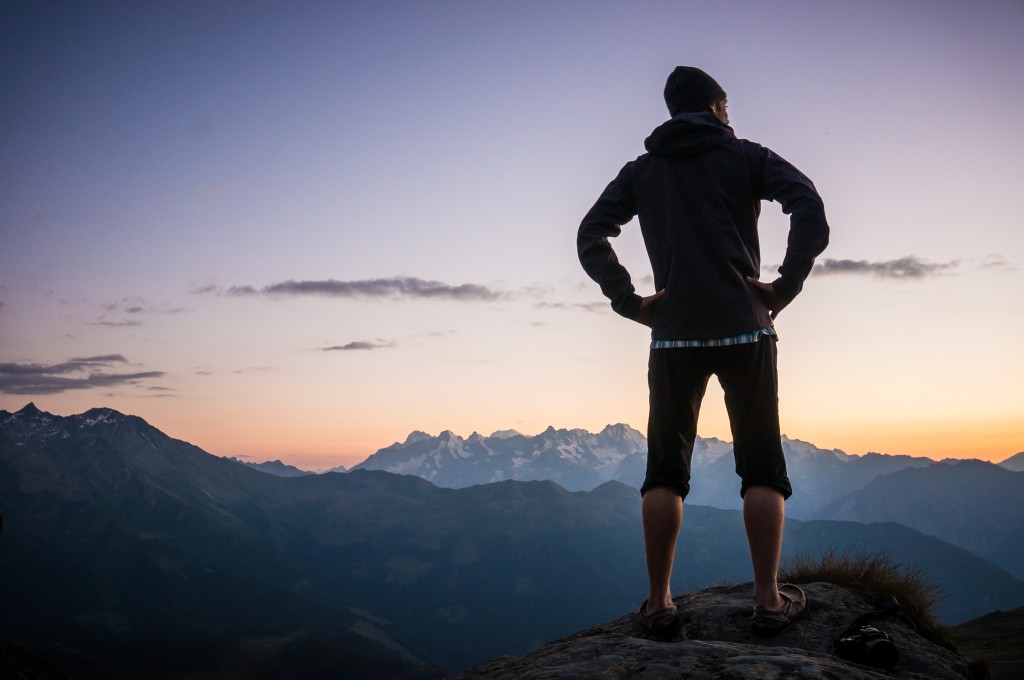
Here we also first met Brian and Denise. Brian is an avid photographer as well (he’s got a great blog too), packing both a DSLR and a tripod on his pack. We’d met this first along the path near the Le Hattey hut but took the opportunity to get better acquainted at the hut.
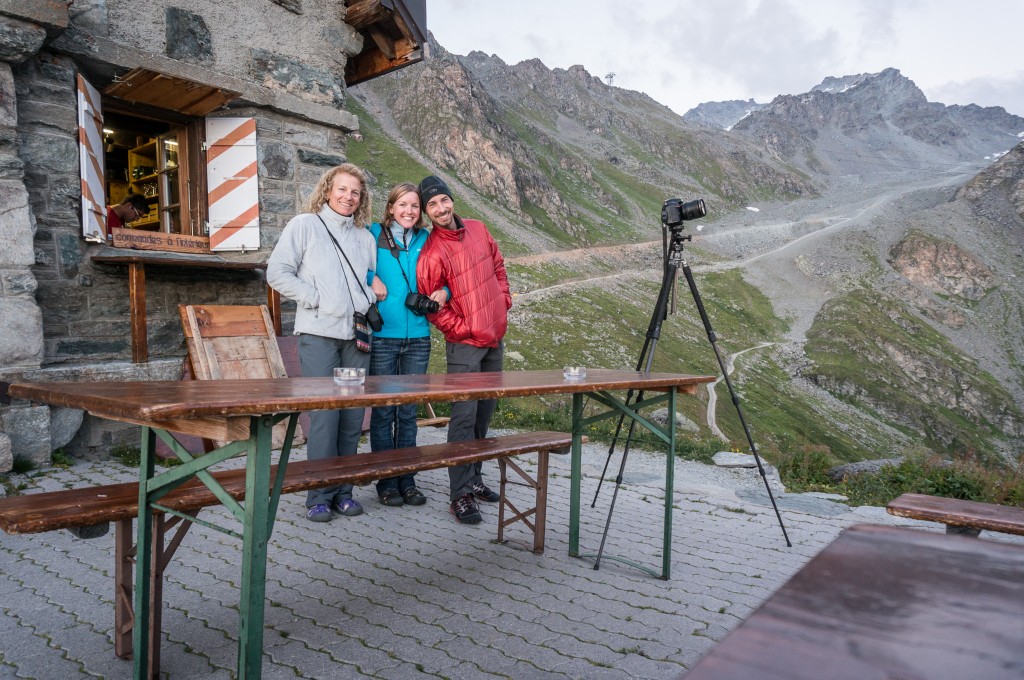
I also took the extra time to try both some long exposure photography as well as some night photography of the hut.

Note: The huts are generally dorm style. At Mont Fort, rooms had 4 bunks and we shared with Kathy and Val. Showers here are coin operated, but there is plenty of hot water and you can stop the water flow (and the timer) to extend your shower while you lather up.
Max elevation: 8077 ft
Min elevation: 2684 ft
